
Cephaloscymnus occidentalis Horn - "Horn's Large-headed Lady" - southmost Texas, AZ to s. CA
Texas Beetle ResourcesReturn to Texas
Entomology - Compiled by Mike
Quinn
An annotated list of
|

Cephaloscymnus
occidentalis Horn - "Horn's Large-headed Lady" - southmost Texas, AZ to s. CA

Cephaloscymnus
zimmermanni australis Gordon - "Southern Large-headed Lady" - central TX to AZ


Cephaloscymnus zimmermanni zimmermanni Crotch - "Zimmermann's Large-headed Lady" - e. US








Stethorus caseyi Gordon & Chapin - "Casey's Lady" - central to south Texas, west to AZ and s. UT.
Stethorus histrio Chazeau - Non-Native species found
at two sites in the Texas Panhandle, Amarillo and near Hart. This is an
Old World sp. that's also present in Chile and Mexico.
Stethorus nigripes Kapur - Non-Native species common in the TX Panhandle and western OK and KS. Native to Australia.
Stethorus pinachi Gordon & Chapin - "Carrizo Lady" - only known from type locality, Carrizo Springs, Dimmit Co., Texas


Stethorus punctum (LeConte)
- "Spider Mite Destroyer" - northern Great Plains to OK and east to the
Atlantic coast as well as along the west coast.

Stethorus
utilis (Horn) - "Useful Lady" - coastal plains from Brownsville to FL and NC.




















Scymnus (Pullus) enochrus Gordon - "Golden Lady" - Trans-Pecos, c. AZ. known from less than 10 spmns.




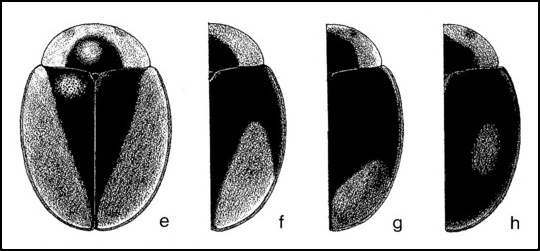
Scymnus (Pullus) loewii Mulsant - "Dusky Lady" - Common from n. to c. TX, Range: e. US to Calif., south to S. Amer.

Scymnus (Pullus) pallens LeConte - "Leathery Lady" - Trans-Pecos, sw US to OR


Scymnus (Scymnus) circumspectus Horn - "Circumspect Lady" - one record near Palestine, TX, e. to AL, n. to MO. Only e. N. Amer. Scymnus sp. w/ pale spot on each elytron.

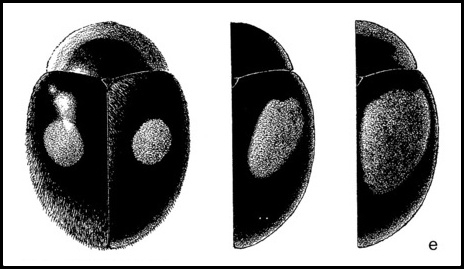
Scymnus (Pullus) pacificus Crotch - "Pacific Lady" - Trans-Pecos, sw US, most records from throughout Calif.

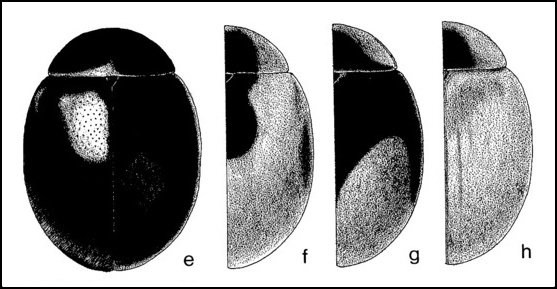
Scymnus (Pullus) brullei Mulsant - "Brullé Lady" - Brownsville, Austin, Dallas, e. N. Amer.



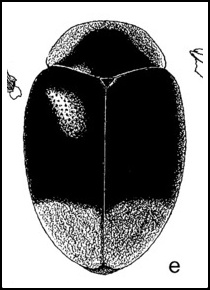
Scymnus (Pullus) rubricaudus Casey - "Red-tailed Lady" - Corpus Christi to Dallas, e. US - rare





Scymnus (Pullus) louisianae J.
Chapin - "Louisiana Lady" - widely dist. c. TX to LA, plus scattered s. US records. One of the most common Scymnus sp. in the TAMUIC and LSAM.


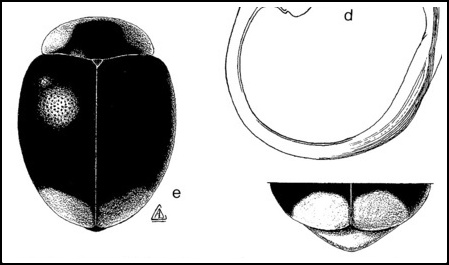
Scymnus (Pullus) fraternus LeConte - "Friendly Lady" - one historical record from College Station, TX, scattered Great Plains records, e. US - rare


Scymnus (Pullus) secures J.
Chapin - "Coastal Scymnus Lady" - coastal sp. from LA to FL to MA. No known TX records. - common in coastal LA
Scymnus (Pullus) gilae Casey - "Gila Lady" - c. CA to AZ, plus one NM record.

Scymnus (Pullus) compar Casey - "Incomparable Lady" - c. TX, e. N. Amer. - 4 spmns coll'ed on Juniper ashei in c. TX March-May.




Scymnus (Pullus) tenebrosus Mulsant - "Darkling Lady" - College Station to e. N. Amer.
Scymnus (Pullus) ardelio Horn - "Wet Lady" - Trans-Pecos, w. US - Type
Scymnus (Pullus) puncticollis LeConte - - Present in LA and e. US, but no known TX records - Type

Scymnus (Pullus) caudalis LeConte - "Caudal Lady" - Two TX records, Brownsville and Dallas, plus scattered e. N. Amer. records to Manitoba.




Scymnus (Pullus) creperus Mulsant - "Creepy Lady" - Throughout TX, se US to NM. one of the most common Scymnus sp. in the TAMUIC.


Scymnus (Pullus) horni Gorham - "Horn Lady" - Hidalgo Co. to central TX to CA, extremely common in w. TX.

Scymnus (Pullus) garlandicus Casey - "Garland
Lady" - limited records in the central Rockies, including Santa Fe, NM


Scymnus (Pullus) socer LeConte - "Soccer Lady" - central TX to NJ

Scymnus (Pullus) uncus Wingo - "Hooked Lady" - rarely coll'ed sp. with scattered e. US records to AB. One record from Kerrville, TX.


Scymnus (Scymnus) apicanus J. Chapin - "Apex Lady" - one record from Del Rio area, e. US to Alberta


Scymnus (Scymnus) indianensis Weise - "Indiana Lady" - Houston-FL-NH


Scymnus (Scymnus) p. paracanus J. Chapin - "Paracanus Lady" - east TX, se US
Scymnus (Pullus) aridus Casey - "Dry Lady" - El Paso, w. US
Scymnus (Pullus) cockerelli Casey - "Cockerell Lady" - El Paso, sw US
Scymnus (Pullus) gilae Casey - "Gila Lady" - c. CA to AZ, plus one NM record.
Scymnus (Pullus) howdeni Gordon - "Howden Lady" - Big Bend National Park - very rare sp.
Scymnus (Pullus) nugator Casey - "Jest Lady" - AZ to w. TX plus a few records further north.
Scymnus (Pullus) pauculus Gordon - "Big Bend Lady" - Big Bend National Park, c. AZ (Oracle) - very rare sp.
Scymnus (Pullus) uteanus Casey - "Utah Lady" - NV-OK-SD-UT



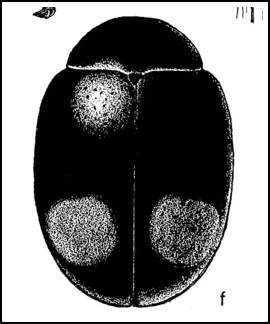
Nephus flavifrons
(Melsheimer) - "Rear-spot Lady" - e. US to RGV and Latimer Co., OK. Also se AZ.

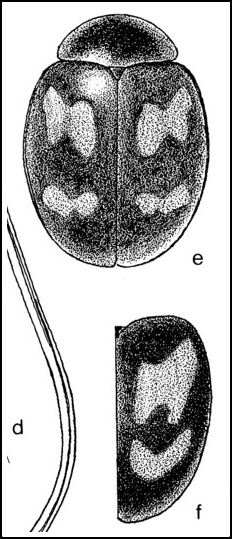
Nephus guttulatus
(LeConte) - "San Franscisco Lady" - Most records from CA, but scattered sw US and Trans-Pecos
records.


Nephus
intrusus (Horn) - "Intrusive Lady" - south Texas to SD, e. US


Nephus sordidus (Horn) - "Dirty Lady" - Trans-Pecos, w. N. Amer.

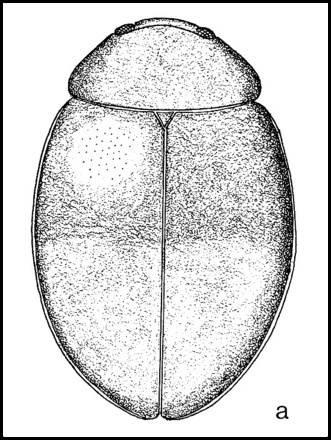
Nephus timberlakei Gordon - "Timberlake's Bicolored Lady" - San Angelo, Brownsville, TX

Nephus (Scymnobius) sp.





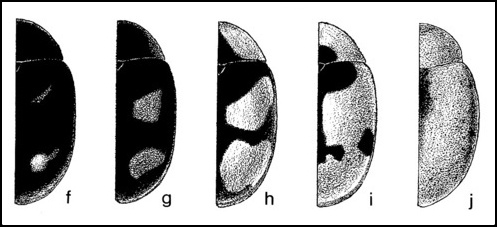
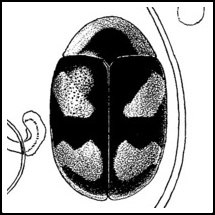
Diomus
amabilis (LeConte) - "Amiable Lady" - e. US to e. TX.



Diomus
debilis (LeConte) - "Weak Lady" - widely scattered records, but most from southwest.

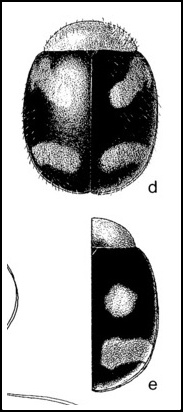
Diomus
liebecki
(Horn) - "Liebeck Lady" - Recorded from OK and e. N. Amer., but
apparently absent from se. US. One literature record from Bentsen-Rio
Grande Valley State Park.


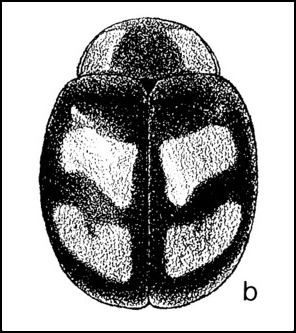
Diomus
pseudotaedatus Gordon - "Non-disgusting Lady" - Cameron and Hidalgo counties, south Texas, plus 5 spmns from east Mexico. - SGCN




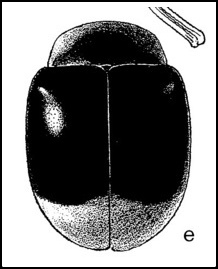
Diomus
terminatus (Say) - "Yellow-tip Lady" - Brownsville to Del Rio to Wichita Falls, e. US


Diomus
texanus Gordon - "West Texas Lady" - Green Gulch, Chisos Basin, BBNP, and Ft. Davis, west Texas.






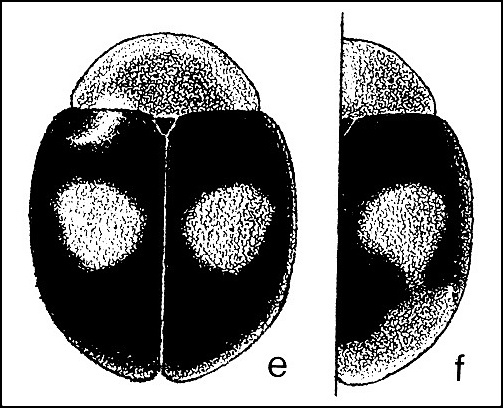

Selvadius sp. - Hidalgo Co., possible new US record
Selvadius megacephalus (Fall) - "Pasadena Lady" - Five locality records from s. CA to NM.

Selvadius nunenmacheri Gordon - "Nunenmacher Lady" - WY(2), CO(2), AZ(1), and OK(1), but no identified TX records.





Helesius
nubilans
Casey - "Stormy Lady" - nr. Lubbock to Brownsville. TX, known from four spmns coll'ed ca. 1897 to 1969.




Thalassa
montezumae Mulsant - "Montezuma Lady" - Houston, Brownsville, se AZ; introduced into FL / Mex. to S. Amer.




Hyperaspis
globula Casey - "Globular Lady" - Cameron and Hidalgo Counties, southmost Texas






Hyperaspis proba (Say) - "The Good Lady" - Trans-Pecos to New England and SD



Hyperaspis rivularis Dobzhansky - "Rival Lady" - Known from AR(3), IL(1), KY(1), MO(6) and LA(1).





Hyperaspis
weisei Schaeffer - "Weise Lady" (pronounced, "Vice Lady") - Known from RGV and Davis Mtns.



Hyperaspis binotata (Say) - "Doubly-noted Lady" - Common, widespread e. N. Amer. to LA and OK. Requires disection of male genitalia to confirm ID.



Hyperaspis haematosticta Fall - "Blood-spotted Lady" - Four locality records from AZ and NM.


Hyperaspis inedita Mulsant
- "Unedited Lady" - recorded from LA & OK, and scattered se US, but no TX record as yet.


Hyperaspis lewisi Crotch - "Lewis Lady" - e. US to southmost Texas




Hyperaspis octonotata Casey - "Eight-spot Lady" - sw US to southmost TX
signata group



Hyperaspis conviva Casey
- "Lively Lady" - Reported from OK and LA, but not TX. Occurs across se
US, up the Atlantic seaboard, and back across s. Canada.



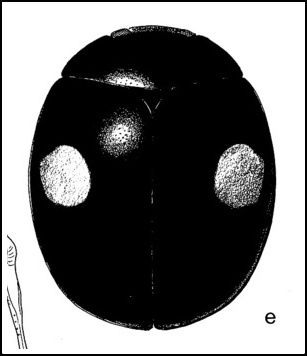
Hyperaspis pistillata
Watson - "Pistol Lady" - Elytron with one or 2 yellow or red spots -
coastal plain from LA to FL to MA, but not listed in Chapin (1974).





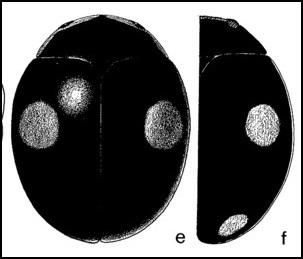
Hyperaspis
signata (Olivier) - e. US to e. TX


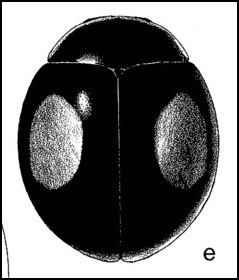
Hyperaspis signata bicentralis Casey - "Bicentral Lady" - c. TX to Houston to OK
bigeminata group




Hyperaspis
bigeminata (Randall) - "Bigeminy Lady" - Common from Dallas to San Antonia to Houston, to e. NA.


Hyperaspis deludens Gordon - "Deceptive Lady" - AR, IL, OH (one record each)



Hyperaspis gemina LeConte - "Double-yellow Lady" - scattered se. US records: GA to VA, and OK






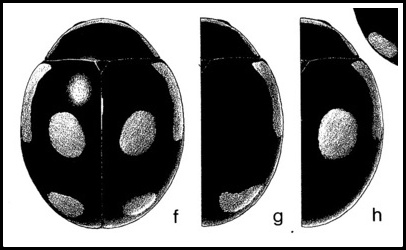
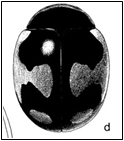
Hyperaspis
lateralis Mulsant - "Lateral Lady" - fairly common in Dallas area, ranges through w. N. Amer. Pattern highly variable.




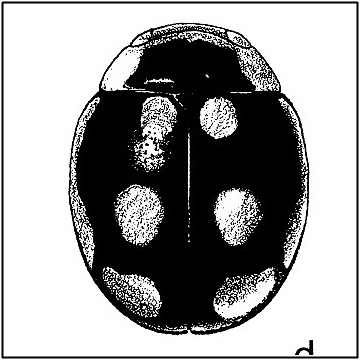
Hyperaspis
levrati (Mulsant) - "Levrat Lady" - se AZ, Del Rio, TX / Mex.


Hyperaspis lugubris
(Randall) - "Mourning Lady" - Lake Brownwood State Park to New Mexico, north to ND and MN



Hyperaspis
medialis Casey - "Medial Lady" - se AZ, Alpine and Brownsville, TX




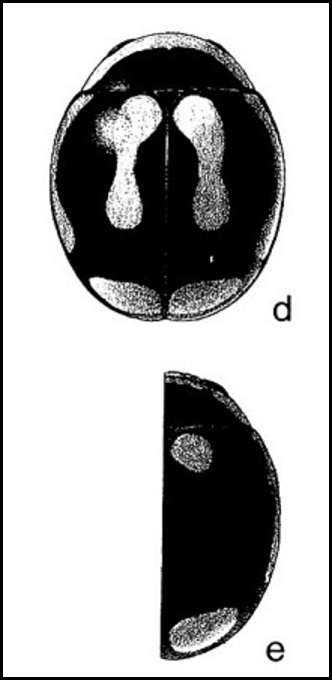
Hyperaspis revocans Casey - "Revoked Lady" - c. CA to sc. NM



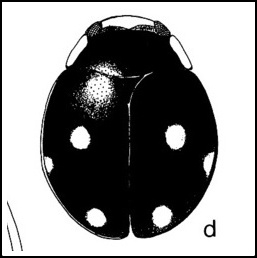
Hyperaspis triangulum Casey - "Triad Lady" - Trans-Pecos, se AZ




Hyperaspis wickhami Casey - "Wickham Lady" - central Texas at least to c. Mex.



Hyperaspis
connectens (Thunberg) - "Connected Lady" - mostly e. TX to RGV, ranges across southern tier of states, south to C. Amer.




Hyperaspis
rotunda Casey - "Rotund Lady" - southmost Texas (AZ records likely in error) - SGCN



Hyperaspis
conspirans Casey - "Conspired Lady" - AZ, Davis and Chisos Mtns




Hyperaspis fastidiosa Casey - "Fastidious Lady" - Widely dist. west of the Rockies, plus two records from NM




Hyperaspis gemma Casey - "Lady Bud Beetle" - s. Calif. to Alpine, TX



Hyperaspis cruenta LeConte - "Bloody Lady" - s. NM to Dallas



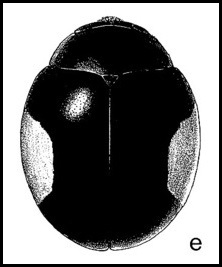
Hyperaspis significans Casey - "Significant Lady" - s. CA to sw NM



Hyperaspis
bensonica Casey - "Benson Lady" - s. CA, se AZ, Davis Mtns. (Named for Benson, AZ, not Bentsen State Park)


Hyperaspis
caseyi Gordon - "Red-lined Lady" - sw US to Dallas, plus one WA record





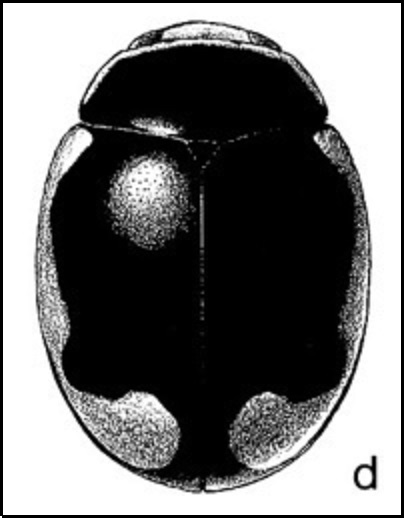
Hyperaspis
inflexa
Casey - "Curvy Lady" - widely distributed across N. Amer. Mostly coll'ed on Juniper during c. TX arboreal surveys.





Hyperaspis pleuralis Casey - "Side-spot Lady" - mostly w. US, plus Trans-Pecos and Pt. Isabel.


Hyperaspis
schaefferi Gordon - "Schaeffer Lady" - Brownsville, Goliad, and Columbus, TX


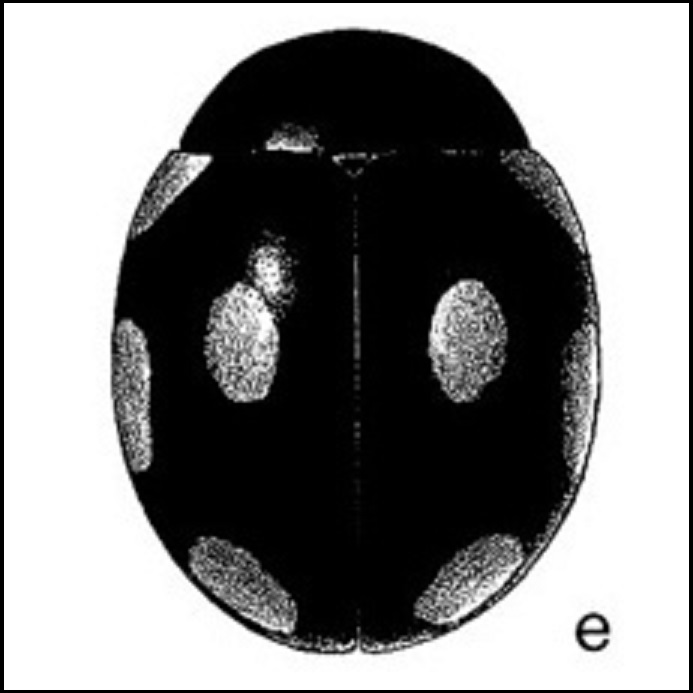






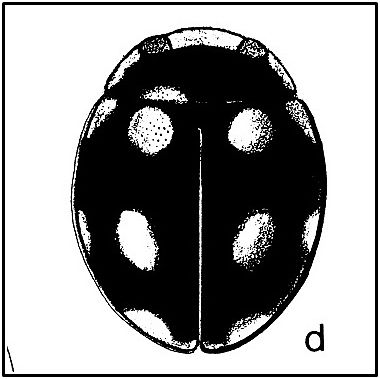






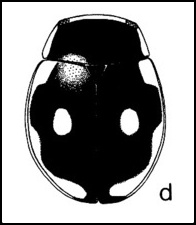
Hyperaspis
imitator Gordon - "Imitation Lady" - known from 2 spmns coll'ed in c. TX: Bexar Co. in 1947 and Uvalde Co. in 1986.




Hyperaspis
punctata LeConte - "Low Punctate Lady" - sc NM to s. TX, n. to OK



Hyperaspis quadrivittata LeConte - "Four-lined Lady" - w. N. Amer. Included here due to one known record from c. New Mexico.



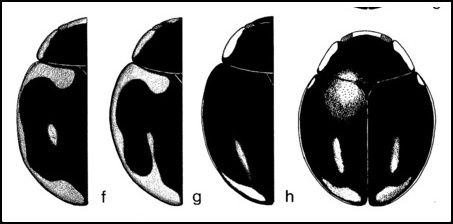
Hyperaspis
trifurcata Schaeffer - "Trident Lady" - Dallas to RGV, fairly common in c. TX, plus a few western records



Hyperaspis n. sp. (Det. R. Gordon, by
dissection) - "Six-spotted Lady" - only known from seven spmns from Latimer Co., Oklahoma






Hyperaspis n. sp. - "Pink Lady" - southmost TX (Santa Ana NWR) - New US Record






















Hyperaspidius spp. - Given the range of inter-
and intraspecific species variation, the majority of members of this
genus can not be reliably determined without dissection.


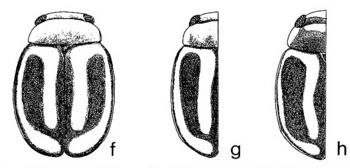
Hyperaspidius comparatus Casey - "Comparative Lady" - British Columbia to sw US.
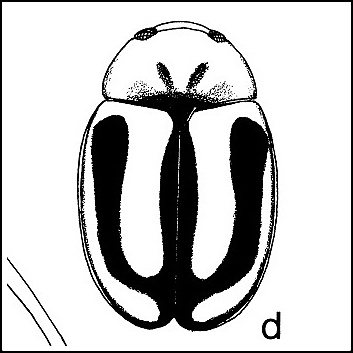
Hyperaspidius ingenitus Casey - "Ingenious Lady" - Only known from Las Cruces, southcentral New Mexico.
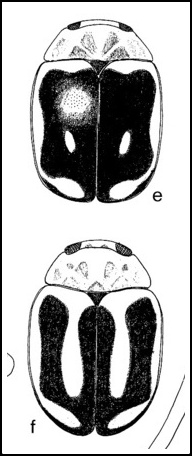
Hyperaspidius insignis Casey - "Well-marked Lady" - Known from OK to CO.



Hyperaspidius nanellus Gordon - "Pale Dwarf Lady" - southmost TX to OK (Cameron, Brown, Burleson, Edwards and Latimer counties)


Hyperaspidius marginatus
(Gaines) - "Marginal Lady" - Welder Wildlife Refuge, Sinton to Latimer Co., OK. Type Locality: College Station.


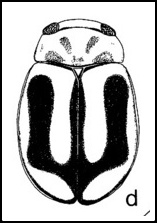
Hyperaspidius oblongus Casey - "Oblong Lady" - El Paso, Columbus, and San Diego. (Plus Crane Co., det. J. E. Wappes, 1997)
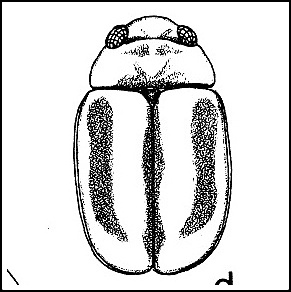
Hyperaspidius shauli Nunenmacher - "Shaul's Lady" - Only known from type locality in the Texas Panhandle.

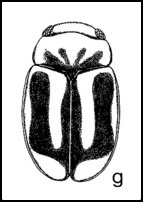
Hyperaspidius vittigerus (LeConte)
- "Vittate Lady" - se NM to Alberta where it's the most common member
of the genus. Three historical records from College Station that need
confirmation.





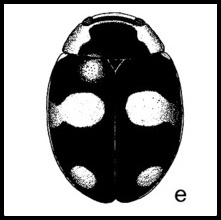
Brachiacantha
barberi Gordon - "Barber Lady" - Widespread across c. and s. TX per spmns in the TAMUIC


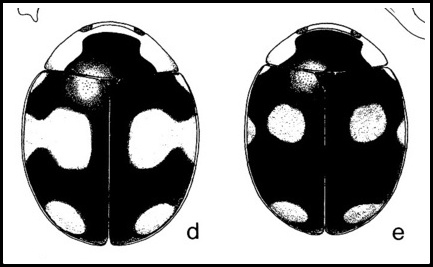
Brachiacantha
decora Casey - "Decorated Lady" - c. AZ, southern half of TX, s. FL / Mex. to S. Amer.






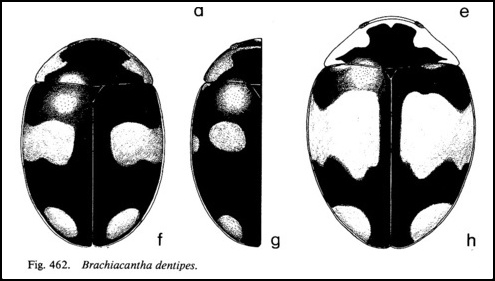
Brachiacantha dentipes (Fabricius)
- "Carolina Lady" - Records from NM, OK, AR, and LA, plus one historical record from e. TX. Widely dist. across e. US.




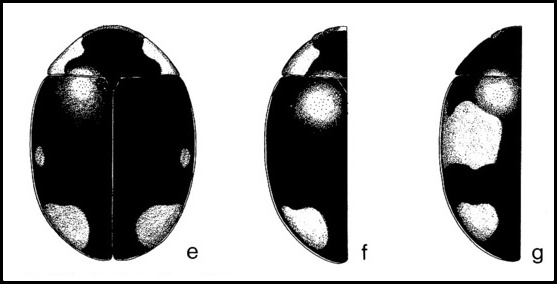




Brachiacantha
quadrillum LeConte - "Four-spot Lady" - Red River to Rio Grande

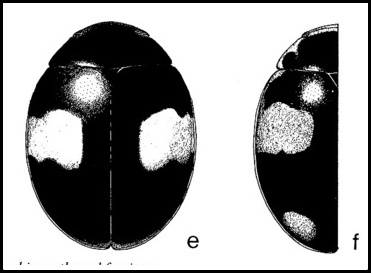
Brachiacantha
subfasciata Mulsant - "Semi-banded Lady" - central to south TX, se AZ







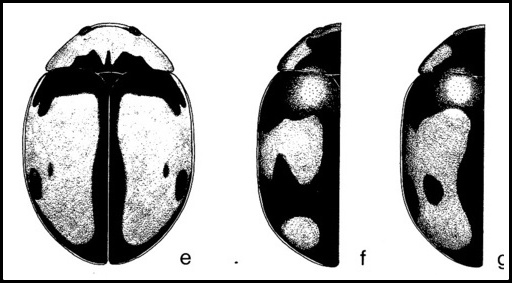














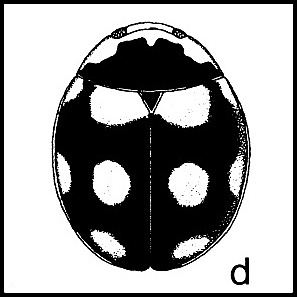



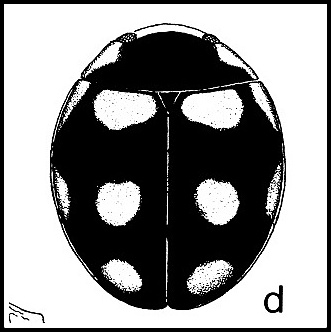
Brachiacantha
testudo Casey - "Turtle Lady" - c. to s. TX




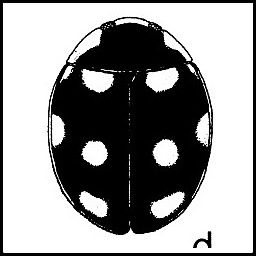
Brachiacantha decempustulata (Melsheimer) - "Ten-spot Lady" - e. N. Amer., one TX record from Concan, Uvalde Co.


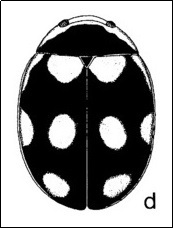
Brachyacantha uteella Casey - "Little Ute Lady" western N. Amer., one NM record, Santa Fe




Brachiacantha lepida
Mulsant - "Hourglass Lady" - pre-1873 historical literature record for
"Texas". Sp. occurs in northern Tamaulipas, ne. Mexico to C. Amer.



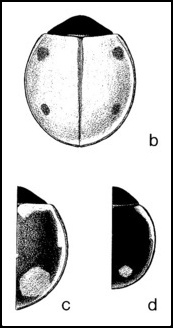

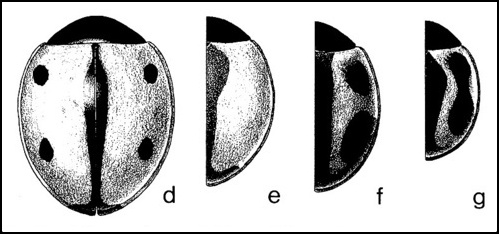





Axion plagiatum (Olivier) - "Spot-sided Lady" - Uncommon in TX, LA,OK, occurs west to to CA and OR.





Axion tripustulatum (DeGeer) - "Pimple Lady" - east TX, e US
Genus Exochomus - Predators of mealybugs and scales

Exochomus aethiops (Bland) - "Burnt Lady" - w. US to Jeff Davis Co. and Lubbock (s.CA-w.TX-w.SD-s.AB)




Exochomus childreni guexi LeConte - "Guex Lady" - c. & s. TX to LA
(Exochomus childreni childreni Mulsant - Florida)

Exochomus marginipennis (J. E. LeConte) - "Children-esque Lady" - e. TX, e. US (only Fig. h occurs in Texas, elytral punctation coarse vs. childreni)




Exochomus subrotundus Casey - "Semi-rotund Lady" - sw US to w. TXGenus Chilocorus
=
=


Chilocorus cacti (Linnaeus) - "Cactus Lady" - dorsal spots may be large or small, it's the vental pattern that's diagnostic. widely dist. across s. US




Chilocorus stigma (Say) - "Twice-stabbed Lady" - mostly coll'ed on oaks during c. TX arboreal surveys. most of N. Amer., (except w. coast)

Curinus coeruleus (Mulsant) - "Blue Lady" - No Texas records, but occurs in Nuevo Leon, Mexico to S. Amer., also FL and Cuba
Rhyzobius
lophanthae (Blaisdell) - "Purlple Scale Predator" - Non-Native - se US to CA












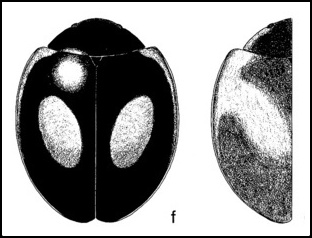








Genus Naemia



Naemia seriata (Melsheimer) - "Seaside Lady" - Atlantic Coast from Brownsville, TX to New Brunswick, Canada. Feeds on both insects and pollen.
Genus Coleomegilla



Coleomegilla maculata (Degeer) - "Pink Spotted Lady" - e. NA to sw US / Mex. to S. Amer. / Cuba
Prey generalist feeding on wdie variety of aphids, but also chrysomelid and lepidopteran eggs and larvae as well as pollen. Prefers moist habitats where it can be locally abundant.
Coleomegilla maculata fuscilabris (Mulsant) - coastal Louisiana to Florida and South Carolina
Coleomegilla maculata lengi Timberlake - e. N. Amer.
Coleomegilla maculata strenua (Casey) - sw USRecent research suggests the above subspecies may be full species. (Krafsur and Obrycki 2000), (Perez and Hoy 2002)
Genus Hippodamia - Predacious on aphids on grasses
Species with convergent pronotal lines





Hippodamia convergens Guérin-Méneville - "Convergent Lady" - throughout US and sw Canada. May be abundant in or near argo-ecosystems.



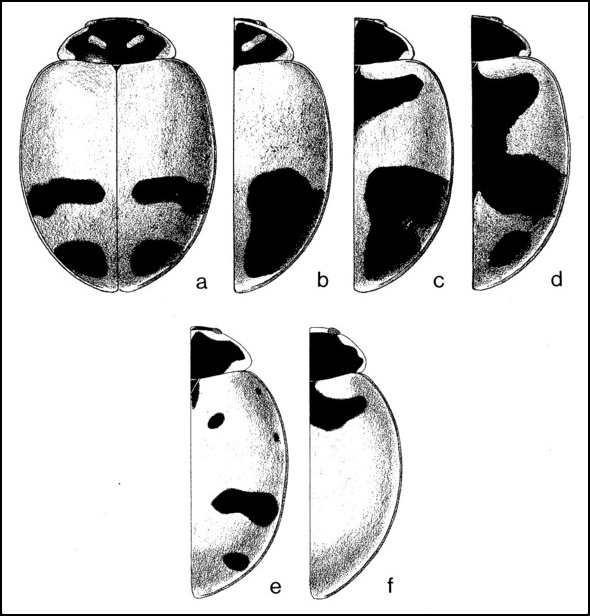
Hippodamia glacialis glacialis (Fabricius) - "Glacial Lady" - (Fig. a, b) - e US, except se US: OK-VA-MA-ND
Hippodamia glacialis lecontei Mulsant - "LeConte Lady" - (Fig. c-e) - sw US to AB-SK



Hippodamia quindecimmaculata Mulsant - "Fifteen-spotted Lady" - LA, AR, NE, CO, but most records in the Upper Mid-West. No confirmed Texas records.
Hippodamia quinquesignata (Kirby) - "Five-spot Lady" - NM plus one report from Latimer Co., OK. Most records from w. N. Amer., with scatterd e. N. Amer. records. No confirmed TX records.



Hippodamia sinuata crotchi Casey - "Sinuate Lady" - Texas Panhandle, western N. Amer.
Species without convergent pronotal lines
- Apex of elytron with sutural margin black



Hippodamia apicalis Casey - "Black-apical Lady" - s. CA to CO to BC. Range touches northwestern New Mexico.





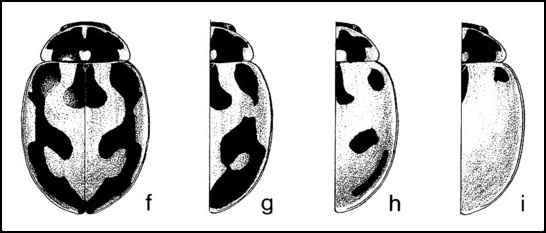
Hippodamia expurgata Casey - “Expurgate Lady” - Ranges though the Rocky Mountain west, including most of New Mexico. Not separable from apicalis without dissection.
- Apex of elytron with sutural margin never black





Hippodamia parenthesis (Say) - "Parenthesis Lady" - Across US to e AK. but absent from se US.





Hippodamia tredecimpunctata (Linnaeus) - "Thirteen-spot Lady" - no TX records, but Karl Stephan recorded 2 spmns from Latimer Co., OK and Chapin (1974) recorded it from three counties in AR. Ranges across n. US and Canada. Habitat: reed beds and marches.Genus Adalia








Adalia bipunctata (Linnaeus) - "Two-spot Lady" - still present in New Mexico, w. N. Amer. Historical records from AR, LA, OK and TX. Present range in and around boreal forests. Predatory on aphids of trees and shrubs.Genus Coccinella - Aphidophagous





Coccinella septempunctata Linnaeus - "Seven-spot Lady" - Non-Native - throughout N. Amer. and Texas. Found mostly on Juniper during c. TX arboreal surveys. This widely distributed species has induced other members of the genus to retreat to in or near boreal forests.



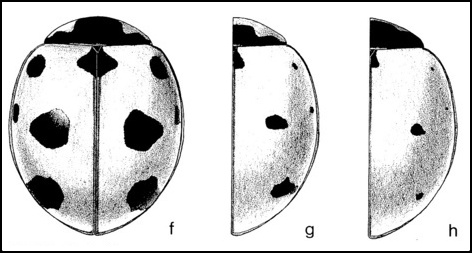
Coccinella novemnotata Herbst - "Nine-spot Lady" - Apparently never common in Texas, most recently collect in 1978 in Huntsville. Historical records from Amarillo and Dallas. Currently limited to w. N. Amer., upper midwest, and Long Island, NY



Coccinella monticola Mulsant - "Mountain Lady" - formerly common in NM. Still present in CO. and in Nuevo Leon, MX. No TX records.




Coccinella transversoguttata Mulsant - "Transverse Lady" - Two historical records from San Antonio and Colorado Co., TX (Dobzhansky 1931) Still present in NM. Inhabits broad-leaved trees and shrubs.



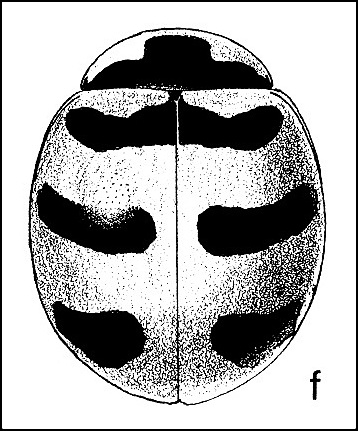
Coccinella trifasciata Linnaeus - "Three-banded Lady" - One historical state record (possibly from Amarillo?) and one record from northern NM (Dobzhansky 1931). Still present across northern US and southern Canada to Alaska. Inhabits grasses and shruby vegetation.
Genus Cycloneda



Cycloneda munda (Say) - "Orange Lady" - central TX and north, e. US




Cycloneda sanguinea (Linnaeus) - "Red Lady" - mostly central TX and south, CA to VA, but mostly CA, TX, FL


Cycloneda polita (Casey) - "Polished Lady" - New Mexico and west, mostly west coast.Genus Harmonia





Harmonia axyridis (Pallas) - "Harmonia Beetle" - Non-Native - throughout N. Amer., though relatively uncommon in the Rocky Mtn states.Genus Anatis - Aphidophagous






Anatis labiculata (Say) - "Greater Fifteen-spot" - e. N. Amer. to c. TX, absent from se coast. Few modern TX records.



Anatis lecontei Casey - "Giant Lady" - Guadalupe Mountains, and Rocky Mountain region
Genus Myzia - Aphidophagous, usually on conifers



Myzia interrupta (Casey) - "Pumpkin Lady" - Trans-Pecos, w. N. Amer.




Myzia pullata (Say) - "Front-spotted Lady" - Dallas, College Station, e. N. Amer. to Alberta
Genus Neda


Neda marginatis (Mulsant) - "Neda Lady" - Rare historical stray to shouthmost Texas, common in ne Mexico. Ranges to C. Amer.Genus Paraneda
=
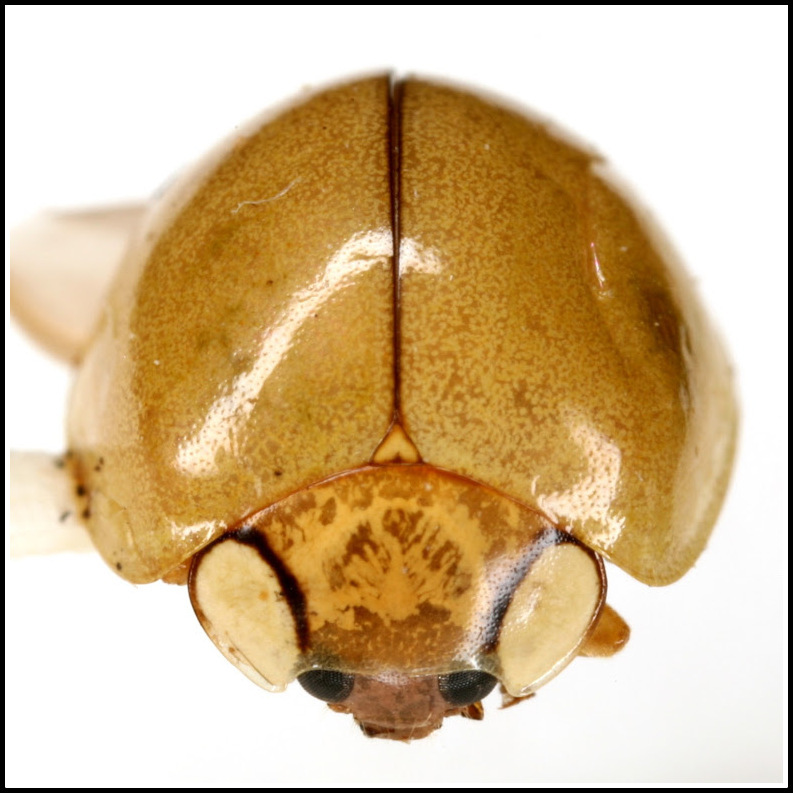
Paraneda pallidula (Mulsant) - "Pale Lady" - Range: ne Mexico to S. Amer. No Texas records.
Genus Olla






Olla v-nigrum (Mulsant) - "Ashy Gray Lady" - Common across Texas, mostly southern half of US, south to S. Amer.
Genus Neoharmonia - Feeds on chrysomelid eggs and larvae





Neoharmonia venusta ampla (Mulsant) - "(Western) Charming Lady" - southmost TX to AZ - uncommon






Neoharmonia venusta venusta (Melsheimer) - "(Eastern) Charming Lady" - c. TX to e. US.
Genus Mulsantina



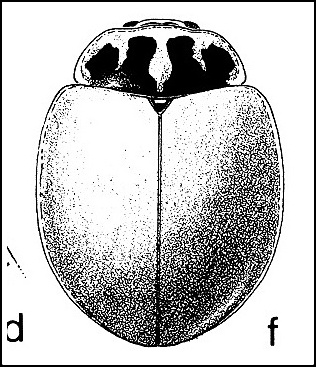
Mulsantina luteodorsa J. Chapin - "Clay Lady" - Just east of the TX-LA border to sw NC, plus one record from n. VA. No known TX records.

Mulsantina quinquelineata (Mulsant) - "Five-lined Lady" - AZ-NM-CO-UT / to c. Mex. Not treated in Gordon (1985)





Mulsantina picta (Randall) - "Painted Lady" - Trans-Pecos, mostly w. N. Amer. with scattered e. N. Amer. records. Formerly widely distributed across N. Amer. Another species mostly reduced to habitats in or near boreal forests.

Mulsantina lynx (Mulsant) - "Lynx Lady" - Nuevo Leon and Tamaulipas, Mexico to Guatemala. Chapin (1985) lists the following record that is partly, if not wholly in error: "Michoacan: Patzcuaro, on orchid at Laredo, Tex."
Mulsantina mexicana J. Chapin - "Chapin's Mexican Lady" - Coahuila and Nuevo Leon to Oaxaca, Mexico
Genus Psyllobora - Feeds on powdery mildews (Mycetophagous)


Psyllobora parvinotata Casey - "Small-spotted Lady" - Coastal Louisiana to Florida

Psyllobora plagiata Schaeffer - "Saddle-bag Lady" - se AZ, Trans-Pecos, rarely collected





Psyllobora renifer Casey - "Renifer Lady" - From along CA-NV border to LA, Rio Grande to Red River in TX. One record from OK Panhandle, but uncommon outside of the southern half of Texas where it occurs from Feb. to Nov. Chapin (1974) reports it occurring widely in LA.


Psyllobora vigintimaculata (Say) - "Twenty-spot Lady" - Occurs north and east of San Antonio in TX, widely dist. across N. Amer. to Alaska. Seems to be most common in coastal states.
Genus Epilachna



Epilachna borealis (Fabricius) - "Squash Beetle" - e. US to Kerrville, TX. No new TX records in the TAMUIC since the 1970s.



Epilachna tredecimnotata (Latreille) - "Thirteen-spot Lady" - se. AZ, Trans-Pecos, southmost TX, s. to S. Amer. - rarely collected. No TX records in the TAMUIC since the 1970s.





Epilachna varivestis Mulsant - "Mexican Bean Beetle" - Historical records from S. and W. TX, mostly occurs in ne. US with a few scattered sw records.
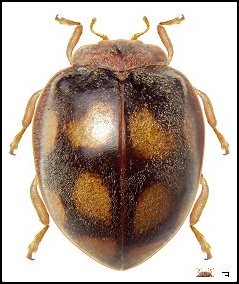
Epilachna mexicana (Guérin-Méneville) - "Bold Lady" - Common variable species from ne. Mexico to S. Amer., no Texas records.
Chapin,
J.B. 1974. The Coccinellidae of Louisiana (Insecta:
Coleoptera). Louisiana Agricultural Experiment Station Bulletin 682: 2-87. [Full Text]
Gaines, J.C. 1933. Notes on Texas Coccinellidae. Bulletin of the Brooklyn Entomological Society 28(5): 211-215. [Full Text]
Gordon, R.D. 1976. The Scymnini (Coleoptera: Coccinellidae) of the United States and Canada: Key to Genera and Revision of Scymnus, Nephus, and Diomus. Bulletin of the Buffalo Society of Natural Sciences 28: 1-362.
Gordon, R.D. 1985. The Coccinellidae (Coleoptera) of America north of Mexico. Journal of the New York Entomological Society 93(1): 1-912. [Full Text]
Quinn, M.A. 2000. Abundance and distribution of potential arthropod
prey species in a typical Golden-cheeked Warbler habitat. Unpublished
Thesis. Texas A&M University, College Station. ix + 182 pp. [Link]
Rouse, E.P., and J.B. Chapin. 1976. A checklist of the Coccinellidae of Arkansas. Proceedings of the Arkansas Academy of Science 30: 76-77.[ Full PDF]
Vandenberg, N.J. 2002. Coccinellidae Latreille 1807. Pp. 371-389. In: Arnett, R.H., Jr., et. al. (Eds.), American Beetles. Vol. 2. CRC Press, Boca Raton, FL.
EGRC - Edward G. Riley Collection, College Station, TX
FMNH - Field Museum of Natural History, Chicago, IL
FSCA - Florida State Collection of Arthropods, Gainesville, FL
OSUC - C.A. Triplehorn Insect Collection, Ohio State University, Columbus, OH
SNMC - Sam Noble Museum - Recent Invertebrates, Oklahoma University, Norman, OK
TAMUIC - Texas A&M University Insect Collection, College Station, TX - Many specimens were determined by Dr. Joan B. Chapin.
USNM - U.S. National Museum, Smithsonian, National Museum of Natural History, Washington, D.C.
UTIC - University of Texas Insect Collection, Austin, TX
BugGuide - Iowa State University
Checklist of the Coleoptera of Oklahoma - Coccinellidae - Oklahoma State University
Family Coccinellidae - Pg. 96-99 In: Peck & Thomas, 1998. A distributional checklist of the beetles (Coleoptera) of Florida.
Illustrated Beetle Inventory of the Sabal Palm Sanctuary (Cameron Co., TX) - Edward G. Riley & Mike Quinn, 2011
Illustrated Beetle Inventory of Lick Creek Park, College Station, Texas - Edward G. Riley, 2011
Lady Bird Johnson Wildflower Center Fauna Project - Val Bugh, Austin, Texas (updated weekly)
List of Coleoptera Collected in Latimer County, Oklahoma by Karl Stephan (2002)
Lost Ladybug Project - Research Findings - Cornell
Acorn, J. 2007. Ladybugs of Alberta, Finding the Spots and Connecting the Dots. University of Alberta Press, Edmonton. xxx + 169 pp.
Adriano, G., N. Vandenberg, J. McHugh, J. Forrester, S. Slipinski, K. Miller, L. Shapiro, M. Whiting. 2009. The evolution of food preferences in Coccinellidae. Biological Control 51(2): 215-231.
Akbar, W., C.E. Carlton, and T.E. Reagan. Diomus terminatus
(Say) (Coleoptera: Coccinellidae) life cycle, larval morphology, and
potential as a biological control agent of the sugarcane aphid, Melanaphis sacchari Zehntner. Annals of the Entomological Society of America 102(1): 96-103.
Alyokhin, A. and G. Sewell. 2004. Changes in a lady beetle community
following the establishment of three alien species. Biological
Invasions 6: 463-471.
Angelet, G.W. and R.L. Jacques. 1975. The establishment of Coccinella septempunctata L. in the Continental United States. USDA Cooperative Economic Insect Report 25: 883-884.
Angalet, G.W., J.M. Tropp, and A.N. Eggart. 1979. Coccinella septempunctata in the United States: recolonizations and notes on its ecology. Environmental Entomology, 8: 896–901.
Balduf, W.V. 1935. The Bionomics of Entomophagous Coleoptera. Chicago, New York, St. Louis. 220 pp.
Banks, C.J. 1955. An ecological study of Coccinellidae associated with Aphis fabae Scop. on Vicia faba. Bulletin of Entomological Research 45: 561-587.Banks, C.J. 1957. The behaviour of individual coccinellid larvae on plants. The British Journal of Animal Behaviour 5: 12-24.
Belicek, J. 1976. Coccinellidae of western Canada and Alaska with analyses of the transmontane zoogeographic relationships between the fauna of British Columbia and Alberta (Insecta:Coleoptera: Coccinellidae). Quaestiones Entomologicae 12: 283-409.
Bennett, F.D. and R.D. Gordon. 1991. New Florida ladybeetles. Florida Entomologist 74: 598-599.
Bentley,
B.L. 1977. Extrafloral nectaries and protection by pugnacious
bodyguards. Annual Review of Ecology and Systematics 8: 407-427.
Biddinger, D., D. Weber, and L. Hull. 2009. Coccinellidae as predators of mites: Stethorini in biological control. Biological Control, 51: 268-283.
Blackman, R.L. 1965. Studies on specificity in Coccinellidae. Annals of Applied Biology 56: 336-38.
Blaisdell, F.E. 1892. A new species of Coleoptera from California. Entomological News 3: 51.
Bland, J.H.B. 1864. Descriptions of several new species of North American Coleoptera. Proceedings of the Entomological Society of Philadelphia 3: 65-72.
Blatchley, W.S. 1910. An illustrated and descriptive catalogue of the Coleoptera or beetles (exclusive of Rhynchophora) known to occur in Indiana. Nature Publishing Co., Indianapolis. 1385 pp.
Blatchley, W.S. 1917. On some new or noteworthy Coleoptera from the west coast of Florida. Canadian Entomologist 49: 137-143.
Bold, T.J. 1873. Note on the recent occurrence in Northumberland and Durham of the Camberwell Beauty Butterfly. Tyneside Naturalists’ Field Club, Transactions of the Natural History Society of Northumberland, Durham and Newcastle upon Tyne. 5: 30-34.
Boving, A. 1917. A generic synopsis of coccinellid larvae in the United States National Museum, with a description of the larva of Hyperaspis binotata Say. Proceedings of the United States National Museum 51: 621-650.
Bradley, G.A. 1973. Effect of Formica obscuripes (Hymenoptera: Formicidae) on the predator-prey relationship between Hyperaspis congressis (Coleoptera: Coccinellidae) and Toumeyella numismaticum (Homoptera: Coccidae). Canadian Entomologist 105: 1113-1118.
Brown, H.D. 1972. Predaceous behaviour of four species of coccinellidae (Coleoptera) associated with the wheat aphid, Schizaphis graminum (Rondani), in South Africa. Transactions of the Entomological Society of London 124: 21-36.
Brown, W.J. 1940. Notes on the American distribution of some species of Coleoptera common to the European and North American continents. Canadian Entomologist 72: 65–78.
Brown, W.J. 1962. A revision of the forms of Coccinella L. occurring in America north of Mexico (Coleoptera: Coccinellidae). Canadian Entomologist 94: 785–808.
Brown, W.J. and R. de Ruette. 1962. An annotated list of the Hippodamiini of Northern America, with a key to the genera (Coleoptera: Coccinellidae). CanadianEntomologist 94: 643-652.
Brown, M.W., and S.S. Miller. 1998. Coccinellidae (Coleoptera) in apple orchards of eastern West Virginia and the impact of invasion by Harmonia axyridis. Entomological News, 109: 143-151.
Bubienko, K. and D. Ciepielewska. 2010. Ladybirds (Coleoptera, Coccinellidae) on the beaches of Gdansk. Aphids and other hemipterous insects, 16: 119-125.
Burke, H.R., et al. 1997. Obituary: Jake C. Gaines (1903-1996). American Entomologist 43(3): 191. [PDF]
Cadotte, M.W., S.M. McMahon, and T. Fukami. 2006. Conceptual ecology and invasion biology: reciprocal approaches to nature. Springer, Dordrecht, Netherlands. xviii + 487 pp.
Carnes, E.K. 1912. Collecting ladybirds (Coccinellidae) by the
ton. Monthly Bulletin of the State Commission of
Horticulture, 1: 71-81.
Carroll, S.C., M.N. Parajulee, and M.D. Arnold. 2007. Survey of lady beetles (Coleoptera: Coccinellidae) found on Texas high plains cotton, alfalfa and weeds. Proceedings of the World Cotton Conference (September 10–14, 2007), Lubbock, TX. [Manuscript]
Carnes, E.K. 1912. An explanation of the hibernating habits of Hippodamia convergens. Monthly bulletin (California. State Commission of Horticulture) 1: 177-188.
Cartwright, B.O., R.D. Eikenbary, G.W. Angalet & R. K. Campbell. 1979. Release and establishment of Coccinella septempunctata in Oklahoma. Environmental Entomology 8(5): 819-823.
Casey, T.L. 1899. A revision of the American Coccinellidae. Journal of the New York Entomological Society 7: 71-169.
Casey, T.L. 1908. Notes on the Coccinellidae, The Canadian Entomologist 40: 393-421.
Casey, T.L. 1924. Additions to the known Coleoptera of North America. Mem. Coleoptera, 11: 1-347.
Chapin, E.A. 1946. Review of the New World species of Hippodamia Dejean (Coleoptera: Coccinellidae). Smithsonian Miscellaneous Collections 106(11): 1-39.
Chapin, J.B. 1971. The Coccinellidae of Louisiana (Insecta: Coleoptera). Doctoral Dissertation. Louisiana State University, Baton Rouge. xiv + 214 pp.
Chapin, J.B. 1973. New species of lady beetles in the genera Scymnus and Mulsantina (Coleoptera:
Coccinellidae). Annals of the Entomological Society of America 66: 1071-1073.
Chapin, J.B. 1974. The Coccinellidae of Louisiana (Insecta: Coleoptera). Louisiana Agricultural Experiment Station Bulletin 682: 2-87.
Chapin, J.B. 1985. Revision of the genus Mulsantina Weise (Coleoptera: Coccinellidae). Annals of the Entomological Society of America, 78: 348-368.
Chapin, J.B., and V.A. Brou. 1991. Harmonia axyridis (Pallas), the third species of the genus to be found in the United States (Coleoptera: Coccinellidae). Proceedings of the Entomological Society of Washington 93(3): 630-635. Full PDF (First published report of this sp. for N. Amer.)
Chapman, J.A., Romer, J.I. & Stark, J. 1955. Ladybird beetles and army cutworm adults as food for grizzly bears in Montana. Ecology, 36: 156-158.
Chazeau, J., J. Étienne and H. Fürsch. 1974. Les Coccinellidae de l'Île de la Réunion (Insecta Coleoptera). Bulletin du Muséum d'Histoire Naturelle (3), 210(zoology 140): 265-297.
Clausen, C.P. 1916. Life-History and feeding records of a series of California Coccinellidae. University of California Publications, Entomology 1(6): 251-300.
Clausen, C.P. 1972. Entomophagous Insects. Hafner Publishing, New York. x + 688 pp.
Colautti, R.J. and H.J. MacIsaac. 2004. A neutral terminology to
define ‘invasive’ species. Diversity and Distributions 10: 135-141.
Colunga-Garcia, M, and S.H. Gage. 1998. Arrival, establishment, and habitat use of the multicolored Asian lady beetle (Coleoptera: Coccinellidae) in a Michigan landscape. Environmental Entomology. 27: 1574–1580.
Conway, H. E. and T. J. Kring. 2010 Coccinellids associated with the
cotton aphid (Homoptera: Aphididae) in northeast Arkansas cotton.
Journal of Entomological Science 45(2): 129-139.
Crotch, G.R. 1873. Revision of the Coccinellidae of the United States. Transactions of the American Entomological Society 4: 363-382.
Crotch, G.R. 1874a. Descriptions of new species of Coleoptera from the Pacific Coast of the United States. Transactions of the American Entomological Society 5: 73-80.
Crotch, G.R. 1874b. A revision of the Coleopterous family Coccinellidae. London, xvi + 311 pp.
Dailey, P.J., R.C. Graves, and J.M. Kingsolver. 1978. Survey of Coleoptera on the common milkweed, Asclepias syriaca, at one site in Ohio. The Coleopterists Bulletin 32: 223–229.
Davidson, L., E. Evans. 2010. Frass analysis of diets of aphidophagous lady beetles (Coleoptera: Coccinellidae) in Utah alfalfa fields. Environmental Entomology, 39(2): 576-582.
DeBach, P. (Ed.) 1964. Biological control of insect pests and weeds. Chapman and Hall, London. xxiv + 844 pp.
DeGeer, C. 1775. Memoires pour Servir a l'Histoire des Insectes. Vol. 5. Stockholm, 448 pp.
Denemark, E. and J. Losey. 2010. Causes and consequences of ladybug
washups in the Finger Lakes region of New York State (Coleoptera:
Coccinellidae). Entomologica Americana, 116: 78-88.
Dixon, A.F.G. 2000. Insect predator-prey dynamics: ladybird beetles and biological control. Cambridge University Press, Cambridge, UK. ix + 257 pp.
Dobzhansky, T. 1931. The North American beetles of the genus Coccinella. Proceedings of the United States National Museum 80(4): 1–32.
Dobzhansky, T. 1933. Geographical variation in ladybeetles. The American Naturalist 67: 97–126.
Dobzhansky, T. 1941. Beetles of the genus Hyperaspis inhabiting the United States. Smithsonian Miscellaneous Collections, 101(6): 1-94.
Douglass, J.R. 1930. Hibernation of the convergent lady beetle, Hippodamia convergens Guer., on a mountain peak in New Mexico. Journal of Economic Entomology , 23: 288.
Doutt, R.L. 1958. Vice, virtue and the vedalia. Bulletin of the Entomological Society of America 4: 119–123.
Drea, J.J., Jr. 1956. A biological analysis of the California Chilocorini (Coleoptera: Coccinellidae). Ph.D. Thesis, University of California, Berkeley.
Dreistadt, S.H., K.S. Hagen, and L.G. Bezark. 1995. Harmonia axyridis (Pallas) (Coleoptera: Coccinellidae), first western United States record for the Asiatic lady beetle. Pan-Pacific Entomologist 71: 135-136.
Eddy, C.O. 1940. The Mexican bean beetle, a new pest in Louisiana. In: Entomological Progress. No. 2. Bulletin of the Louisiana Agricultural Experiment Station, 323: 37-38.Edwards, J.G. 1957. Entomology above timberline: II. The attraction of ladybird beetles to mountain tops. Coleopterists’ Bulletin, 11: 41-46.
Elliott, N., R. Kieckhefer, and W. Kauffman. 1996. Effects of an invading coccinellid on native coccinellids in an agricultural landscape. Oecologia, 105(4): 537–544.
Elton, C.S. 1958. The ecology of invasions by animals and plants. Methuen Co., London. 181 pp.
Evans, E.W. 1991. Intra- versus inter-specific interactions of lady beetles (Coleoptera: Coccinellidae) attacking aphids. Oecologia 87: 401–408.
Evans, E.W. 2000. Morphology of invasion: body size patterns associated with establishment of Coccinella septempunctata in western North America. European Journal of Entomology 97: 469–474.
Evans, E.W. 2004. Habitat displacement of North American ladybirds by an introduced species. Ecology 85: 637–647.
Evans, E.W. 2009. Lady beetles as predators
of insects other than Hemiptera. Biological Control 51: 255-
Ewert, M.A. & H.C. Chiang. 1966. Dispersal of three species of coccinellids in corn fields. Canadian Entomologist 98: 999-1003.
Fabricius, J.C. 1775. Systema Entomologiae. Lipsiae, 832 pp.
Fall, H.C. 1907. [i]In[/i]: H.C. Fall, and T.D.A. Cockerell. The Coleoptera of New Mexico. Transactions of the American Entomological Society 33: 145-272.
Fauske, G.M., P.P. Tinerella, and D.A. Rider. 2003. A list of the lady beetles (Coleoptera: Coccinellidae) of North Dakota with new records from North Dakota and Minnesota. Journal of the Kansas Entomological Society 76: 38-46.
Fenton, F.A. 1958. Seasonal distribution in Alfalfa of the Convergent Lady Beetle, Hippodamia convergens Guer. Proceedings of the Oklahoma Academy of Science (for 1957) 38: 54-58.
Finlayson, C., A. Alyokhin, S. Gross, and E. Porter. 2010. Differential consumption of four aphid species by four lady beetle species. Journal of insect science, 10(31): 1–10.
Finlayson, C.J., A.V. Alyokhin, and E.W. Porter. 2009. Interactions of native and non-native lady beetle species (Coleoptera: Coccinellidae) with aphid-tending ants in laboratory arenas. Environmental Entomology, 38(3): 846–855.
Flores, D., and J. Carlson. 2009. Fortuitous establishment of Rhyzobius lophanthae (Coleoptera: Coccinellidae) and Aphytis lingnanesis (Hymenoptera: Encyrtidae) in South Texas on the Cycad Aulacaspis Scale, Aulacaspis yasumatsui (Hemiptera: Diaspididae). Southwestern Entomologist 34(4): 489-492.
Foley, I. A., M. A. Ivie, and P. M. Denke. 2009. The first state record for the multicolored Asian lady beetle, Harmonia axyridis (Pallas) (Coleoptera: Coccinellidae), from Montana. The Coleopterists Bulletin 63: 351–352.
Forbes, S.A. 1883. The food relations of the Carabidae and Coccinellidae. Bulletin of the Illinois State Laboratory of Natural History 6: 33-64.
Fothergill et al. 2010. First Arizona records of the multicolored Asian lady beetle, Harmonia axyridis (Pallas) (Coleoptera: Coccinellidae) Coleopterists Bulletin 64 (1): 51-52.
Francis, F., E. Haubruge, P. Hastir and C. Gaspar. 2001. Effect of aphid host plant on development and reproduction of the third trophic level, the predator Adalia bipunctata (Coleoptera: Coccinellidae). Environmental Entomology 30: 947–952.
Frazier, B.D. and R.R. McGregor. 1992. Temperature-dependent survival and hatching rate of eggs of seven species of Coccinellidae. Canadian Entomologist 124(2): 305-312.
Gaines, J.C. 1933. Notes on Coccinellidae with a description of a new subspecies (Coleoptera). Journal of the New York Entomological Society 41: 263-264.
Gaines, J.C. 1933. Notes on Texas Coccinellidae. Bulletin of the Brooklyn Entomological Society 28(5): 211–215.
Gage, J.H. 1920. The larvae of the Coccinellidae. Illinois Biological Monographs 6: 232–
Glick, P.A. 1939. The distribution of insects, spiders, and mites in the air. U.S. Dept. of Agriculture, Technical Bulletin 673: 1-150.
Gordon, R.D. 1970a. New genera and species of Coccinellidae from the
western United States (Coleoptera). Proceedings of the Entomological
Society of Washington 72: 42-50.
Gordon, R.D. 1970b. The genus Cephaloscymnus Crotch in North America (Coleoptera: Coccinellidae). Proceedings of the Entomological Society of Washington 72: 66-70.
Gordon, R.D. 1970c. A review of the genus Microweisea
Cockerell with a description of a new genus and species of
Coccinellidae from North America (Coleoptera). Proceedings of the
Entomological Society of Washington 72:207-217.
Gordon, R.D. 1970d. A review of the genus Delphastus Casey (Coleoptera: Coccinellidae). Proceedings of the Entomological Society of Washington 72:356-369.
Gordon, R.D. 1974. Notes on Neoharmonia Crotch (Coleoptera: Coccinellidae) in the United States and Mexico. Proceedings of the Entomological Society of Washington 76: 165-171.
Gordon, R.D. 1976. The Scymnini (Coleoptera: Coccinellidae) of the United States and Canada: Key to Genera and Revision of Scymnus, Nephus, and Diomus. Bulletin of the Buffalo Society of Natural Sciences 28: 1-362.
Gordon,
R.D. 1977. Classification and phylogeny of the New World
Sticholotidinae (Coccinellidae). The Coleopterists Bulletin 31(3):
185-228.
Gordon, R.D. 1985. The Coccinellidae (Coleoptera) of America north of Mexico. Journal of the New York Entomological Society 93(1): 1-912.
Gordon, R.D. 1987. The first North American records of Hippodamia variegata (Goeze) (Coleoptera: Coccinellidae). Journal of the New York Entomological Society 95: 307–309.
Gordon, R.D. 1993. Stethorus nigripes Kapur new to North America, and a new synonym in Stethorus Weise (Coleoptera: Coccinellidae). Southwest. Entomol. l8: 67-68.
Gordon, R.D. 1994. Arawana scapularis (Coleoptera, Coccinellidae) in the United states and new locality records for species of Arawana. Entomological News 105(3): 133-136.
Gordon, R.D. 1994. South American Coccinellidae (Coleoptera) Part III: definition of Exoplectrinae Crotch, Azyinae Mulsant, and Coccidulinae Crotch; a taxonomic revision of Coccidulini. Revista Brasileira de Entomologia 38, 681-775.
Gordon, R.D. and C. Canepari. 2008. South American Coccinellidae (Coleoptera), Part XI: a systematic revision of Hyperaspidini (Hyperaspidinae). Annali del Museo Civico di Storia Naturale “G. Doria” XCIX: 245-512.
Gordon, R.D., C. Canepari and G.A. Hanley. 2014. South American
Coccinellidae (Coleoptera), Part XVI: systematic revision of
Brachiacantha Dejean (Coccinellinae: Hyperaspidini). Insecta Mundi
0390: 1–76.
Gordon, R.D. and E.A. Chapin. 1983. A revision of the New World species of Stethorus Weise (Coleoptera: Coccinellidae). Transactions of the American Entomological Society 109: 229-276.
Gordon, R.D. and N. Vandenberg. 1991. Field guide to recently
introduced species of Coccinellidae (Coleoptera) in North America, with
a revised key to north American genera of coccinellini. Proceedings of
the Entomological Society of Washington 93: 845-867.
Gorham, H.S. 1894. Biologia Centrali-Americana, Insecta, Coleoptera: Coccinellidae 7: 177-208.
Gorham, H.S. 1897. Biologia Centrali-Americana, Insecta, Coleoptera: Coccinellidae 7: 217-240.
Grenier, S., P.D. Greany and A.S. Cohen. 1994. Potential for mass release of insect parasitoids and predators through development of artificial culture techniques. Pp. 181-205 In: Rosen D, Bennett FD, Capinera JL. Pest Management in the Subtropics. Biological Control - A Florida Perspective. Intercept, Andover, UK.
Groden, E., F.A. Drummond, R.A. Casagrande, and D.L. Haynes. 1990. Coleomegilla maculata (Coleoptera: Coccinellidae) its predation upon the Colorado potato beetle (Coleoptera: Chrysomelidae) and its incidence in potatoes and surrounding crops. Journal of Economic Entomology 83: 1306–1315.
Guerin-Meneville, F. E. 1829-1844. Iconographie du Regne Animal de Cuvier. Vol. 7, Insectes, 1829-1838. Paris, 576 pp.
Gurney, B. and N.W. Hussey. 1970. Evaluation of some coccinellid species for the biological control of aphids in protected cropping. Annals of Applied Biology 65: 451-458.
Hagen, K.S. 1962. Biology and ecology of predaceous Coccinellidae. Annual Review of Entomology 7: 289-326.
Hagen, K.S. 1974. The significance of predaceous Coccinellidae in biological and integrated control of insects. Entomophaga, Mem. Hors Ser. 7: 25-44.
Hall, D.G. 2001. Notes on the yellow sugarcane aphid Sipha flava (Homoptera: Aphididae) and the lady beetle Diomus terminatus (Coleoptera: Coccinellidae) in Florida. The Journal of the American Society of Sugar Cane Technologists 21: 21-29.
Hämäläinen, M. and M. Markula. 1972. Effect of type of food on the fecundity in Coccinella septempunctata L. (Coleoptera: Coccinellidae). Annales Entomologici Fennici 38: 195-99.
Hamilton, R.M., E.B. Dogan, G.B. Schaalje, and G.M. Booth. 1999. Olfactory response of the lady beetle Hippodamia convergens (Coleoptera: Coccinellidae) to prey related odors, including a scanning electron microscopy study of the antennal sensilla. Environmental Entomology 28: 812-822.
Harmon, J.P., E. Stephens, and J. Losey. 2007. The decline of native coccinellids (Coleoptera: Coccinellidae) in the United States and Canada. Journal of Insect Conservation 11: 85-94.
Hatch, M.H. 1961. Beetles of the Pacific Northwest, part III: Pselaphidae and Mversicornia. University of Washington Press, Seattle. 503 pp.
Hawkes, O.A.M. 1926. On the massing of the ladybird, Hippodamia convergens (Coleoptera), in the Yosemite Valley. Proceedings of the General Meetings for Scientific Business of the Zoological Society of London, 1926: 693-705
Heape, W. 1931. Emigration, migration, and nomadism. W. Heffer and Sons, Cambridge, U.K. 369 pp.
Hentz, M.G. and G.S. Nuessly. 2002. Morphology and biology of Diomus terminatus (Coleoptera: Coccinellidae), a predator of Sipha flava (Homoptera: Aphididae). The Florida Entomologist 85: 276–279.
Hesler L.S. 2009. An annotated checklist of the lady beetles (Coleoptera: Coccinellidae) of Iowa, U.S.A. Insecta Mundi 0091: 1-10.
Hesler, L.S., and R.W. Kieckhefer. 2008a. Status of exotic and
previously common native coccinellids (Coleoptera) in South Dakota
landscapes. Journal of the Kansas Entomological Society 81: 29-49.
Hesler, L.S., and R.W. Kieckhefer. 2008b. An annotated and updated
species list of the Coccinellidae (Coleoptera) of South Dakota.
The Coleopterists Bulletin 62: 443-454.
Hesler, L.S., and J.D. Petersen. 2008. Survey for previously common native Coccinellidae (Coleoptera) in the northern Great Plains. The Great Lakes Entomologist 41: 60-72.
Hodek, I. 1967. Bionomics and ecology of predaceous Coccinellidae.Annual Review of Entomology 12: 79-104.
Hodek, I. 1970. Coccinellids and the modern pest management. Bioscience 20: 543-552.
Hodek, I. 1973. Biology of Coccinellidae. Academia, Prague and W. Junk, The Hague. 260 pp.
Hodek I., and Honěk A. 1996. Ecology of Coccinellidae. Kluwer Academic Publishers, Dordrecht, the Netherlands. xvi + 464 pp.
Hodek I., G. Iperti, and M. Hodkova. 1993. Long distance flights in Coccinellidae (Coleoptera). European Journal of Entomology 90: 403-414.
Hodek, I., H.F. van Emden & A. Honěk (eds). 2012. Ecology and behaviour of the ladybird beetles (Coccinellidae). Blackwell Publishing Ltd., Chichester, UK, 561 pp.
Hoebeke, E.R. and A.G. Wheeler. 1980. New distribution records of Coccinella septempunctata L. in the eastern United States (Coleoptera, Coccinellidae). The Coleopterists Bulletin 34: 209-212.
Hoelmer KA, Osborne LS, Yokomi RK. 1993. Reproduction and feeding behavior of Delphastus pusillus (Coleoptera: Coccinellidae), a predator of Bemisia tabaci (Homoptera: Aleyrodidae). Journal of Economic Entomology 86: 322-329.
Hoelmer, K.A. and C.H. Pickett. 2003. Geographic origin and taxonomic history of Delphastus spp. (Coleoptera: Coccinellidae) in commercial culture. Biocontrol Science and Technology 13: 529-535.
Honda, J.Y. and R.F. Luck. 1995. Scale morphology effects on feeding behavior and biological control potential of Rhyzobius lophanthae (Coleoptera: Coccinellidae). Annals of the Entomological Society of America 88(4): 441-450.
Honek, A. 1985. Habitat preferences of aphidophagous coccinellids. Entomophaga 30: 253-264.
Horn, G.H. 1895. Studies in Coccinellidae. Transactions of the American Entomological Society 22: 81-114.
Howard, L.O. 1925. Albert Koebele: an obituary. Journal of Economic Entomology 18(3): 556-562.
Howarth, F.G. 1991. Environmental impacts of classical biological control. Annual Review of Entomology 36: 485–509.
Hoy, M.A. and K.B. Smith. 1982. Evaluation of Stethorus nigripes [Col.: Coccinellidae] for biological control of spider mites in California almond orchards. Entomophaga 27: 301-310.
Iperti, G. 1999. Biodiversity of predaceous Coccinellidae in relation to bioindication and economic importance. Agriculture Ecosystems and Environment 74: 323-342.
Isard, S., Kristovich, D., Gage, S., Jones, C., and N. Laird. 2001. Atmospheric motion systems that influence the redistribution and accumulation of insects on the beaches of the Great Lakes in North America. Aerobiologia 17: 275-291.
Johnson, R.H. 1910. Determinate evolution in the color-pattern of the lady-beetles. Carnegie Institution of Washington, Publication No. 122. iv + 104 pp.
Kajita, Y. 2008. Reproductive tactics of aphidophagous lady beetles: Comparison of a native species and an invasive species that is displacing it. Utah State University - All Graduate Theses and Dissertations, 137: 1-157.
Kieckhefer, R.W. and N.C. Elliott. 1990. A 13-year survey of the aphidophagous Coccinellidae in maize fields in eastern South Dakota. Canadian Entomologist 122(5/6): 579-581.
Kindlmann, P., O. Ameixa, A. Dixon. 2011. Ecological effects of invasive alien species on native communities, with particular emphasis on the interactions between aphids and ladybirds. Biocontrol, 56(4): 469-476.
Kirby, W. 1837. In: Fauna Boreali-Americana by Sir J. Richardson et al., 1829-1837. The Insects. Part 4. London, 325 pp.
Koch, R.L. 2003. The multicolored Asian lady beetle, Harmonia axyridis: A review of its biology, uses in biological control, and non-target impacts. Journal of Insect Science 3(32: 1-16.
Koch, R.L. and T.L. Galvan. 2008. Bad side of a good beetle: The North American experience with Harmonia axyridis. BioControl. 53(1): 23-35.
Koch, R.L.; W.D. Hutchison; R.C. Venette; G.E. Heimpel. 2003. Susceptibility of immature monarch butterfly, Danaus plexippus (Lepidoptera: Nymphalidae: Danainae), to predation by Harmonia axyridis (Coleoptera: Coccinellidae). Biological Control. 28(2): 265-270.
Koch, R.L., R.C. Venette, and W.D. Hutchison. 2005. Influence of alternate prey on predation of monarch butterfly (Lepidoptera: Nymphalidae) larvae by the multicolored Asian lady beetle (Coleoptera: Coccinellidae) Environmental Entomology. 34(2): 410-416.
Koch, R.L., R.C. Venette, and W.D. Hutchison. 2006. Predicted impact
of an exotic generalist predator on monarch butterfly (Lepidoptera:
Nymphalidae) populations: A quantitative risk assessment. Biological
Invasions 8(5): 1179-1193.
Koch, R.L., R.C. Venette, and W.D. Hutchison. 2006. Invasions by Harmonia axyridis (Pallas) (Coleoptera: Coccinellidae) in the Western Hemisphere: Implications for South America. Neotropical Entomology 35(4): 421-434.
Kondratieff, B.C., L. Myers and W.S. Cranshaw. 2007. Survey of
selected arthropod taxa of Fort Sill, Comanche County, Oklahoma. IV.
C.P. Gillette Museum of Arthropod Diversity, Colorado State University
178 pp.
Korschefsky, R. 1931. Coleopterorum Catalogus. Pars 118. Coccinellidae. I. Berlin, 224 pp.
Korschefsky, R. 1932. Coleopterorum Catalogus. Pars 120. Coccinellidae. II. Berlin, 435 pp.
Kovár, I., 1996. Phylogeny. Pp. 19-31. In: Hodek, I., Honek, A. (Eds.), Ecology of Coccinellidae. Kluwer Academic Publishers, Dordrecht.
Krafsur, E.S. and J.J. Obrycki. 2000. Coleomegilla maculata (Coleoptera: Coccinellidae) is a species complex. Annals of the Entomological Society of America 93: 1156-1161.
Kring, T.J., and L. Bush. 1991. Exotic aphid predator, the European lady beetle, established in Arkansas. Arkansas Farm Research 40(1): 11.
Kring, T.J. and F.E. Gilstrap. 1986. Beneficial role of corn leaf aphid, Rhopalosiphum maidis (Fitch) (Homoptera: Aphididae), in maintaining Hippodamia spp. (Coleoptera: Coccinellidae) in grain sorghum. Journal of Crop Protection 5, 125–128.
Kugelann, J.G. 1792-1794. Verzeichniss der in einigen Gegenden Preussens bis jetzt entdeckten Kafer-Arten nebst kurz Nachrichten van denselben. Neues Mag. Entomol. 2: 252-256, 3: 257-306, 4: 477-512, 5: 513-582.
Kuznetsov, V.N., 1997. Lady beetles of the Russian Far East, Memoir No. 1. Center for Systematic Entomology. Sandhill Crane Press, Gainesville.
LaMana, M.L. and J.C. Miller. 1996. Field observations on Harmonia axyridis Pallas (Coleoptera: Coccinellidae) in Oregon. Biological Control. 6: 232-237.
Larochelle, A. 1979. Les Coléoptères Coccinellidae du Québec. Cordulia (Suppl.) 10: 1–111.
Latreille, P.A. 1833. Insectes de l'Amerique equinoxiale. Pp. 65-96 In: A. Humboldt and A. Bonpland, Recueil d' Observations de Zool ogle et d'Anatomie Comparee ; Faites dans l'Ocean Atlantique, dans l'Interieur du Nouveau Continent et dans la Mer du Sud, Pendant les Annees, 1799, 1800, 1801, 1802 et 1803, Vol. 2. Paris.
LeConte, J.E. 1824. Description of some new species of North American insects. Annals of the Lyceum of Natural History of New York 1: 169-173.
LeConte, J.L. 1850. General remarks upon the Coleoptera of Lake Superior. Pp. 201-242 In: Agassiz, Lake Superior: Its Physical Character, Vegetation and Animals, Compared with Those of Other and Similar Regions. Boston.
LeConte, J.L. 1852. Remarks upon the Coccinellidae of the United States. Proceedings of the Academy of Natural Sciences of Philadelphia, 6: 129-145.
LeConte, J.L. 1858. Descriptions of new species of Coleoptera, chiefly collected by the United States and Mexican Boundary Commission, under Maj. W. H. Emory, U.S.A. Proceedings of the Academy of Natural Sciences Philadelphia 10: 59-89.
LeConte, J.L. 1859. The Coleoptera of Kansas and eastern New Mexico. Smithsonian Contributions to Knowledge 11: 1-58.
LeConte, J.L. 1878. The Coleoptera of the alpine regions of the
Rocky Mountains. Bulletin of the United States Geological Survey 4:
447-480.
Lee, R.E., Jr. 1980. Aggregation of lady beetles on the shores of lakes (Coleoptera: Coccinellidae). American Midland Naturalist, 104(2): 295-304.
Leng, C.W. 1903a. Notes on Coccinellidae. Journal of the New York Entomology Society, 11: 35-45.
Leng, C.W. 1903b. Notes on Coccinellidae. II. Journal of the New York Entomology Society, 11: 193-213.
Leng, C.W. 1908. Notes on Coccinellidae. III. Journal of the New York Entomology Society, 16: 33-44.
Leng, C.W. 1911. The species of Brachyacantha of North and South America. Bulletin of the American Museum of Natural History 30: 279-333.
Leng, C.W. 1912. Miscellaneous Notes. Journal of the New York Entomological Society 20: 67-71.
Leng, C.W. 1920. Catalogue of the Coleoptera of America, North of Mexico. John D. Sherman, Jr., Mount Vernon, NY. x + 470 pp.
Linnaeus, C. 1758. Systema Naturae, 10th edition. Stockholm, 826 pp.
Linnaeus, C. 1763. Centuria Insectorum Rariorum. Uppsala, 32 pp.
Linnaeus, C. 1767. Systema Naturae, 12th edition. Stockholm, 830 pp.
Liu, T-X., P.A. Stansly, K.A. Hoelmer, and L.S. Osborne. 1997. Life History of Nephaspis oculatus (Coleoptera: Coccinellidae), a Predator of Bemisia argentifolii (Homoptera: Aleyrodidae). Annals of the Entomological Society of America 90: 776-782.
Longnecker, K. 1930. A study of the Coccinellidae of Iowa. Proceedings of the Iowa Academy of Science 35: 307-311.Losey, J.E., J.E. Perlman, and E.R. Hoebeke. 2007. Citizen scientist rediscovers rare nine-spotted lady beetle, Coccinella novemnotata, in eastern North America. Journal of Insect Conservation 11: 415-417.
Louda, S.M., R.W. Pemberton, M.T. Johnson, and P.A. Follett. 2003. Nontarget effects – the achilles’ heel of biological control? Retrospective analyses to reduce risk associated with biocontrol introductions. Annual Review of Entomology 48: 365–396.
Liu, T-X. and P.A. Stansly. 1996. Morphology of Nephaspis oculatus and Delphastus pusillus (coleoptera: Coccinellidae), predators of Bemisia argentifolii (Homoptera: Aleyrodidae). Proceedings of the Entomological Society of Washington 98: 292-300.
Lundgren, J.G. 2009. Nutritional aspects of non-prey foods in the life histories of predaceous Coccinellidae. Biological Control 51(2): 294–305.
MacKenzie, H.L. 1932. The biology and feeding habits of Hyperaspis lateralis Mulsant (Coleoptera-Coccinellidae). University of California Publications in Entomology 6: 9-20.
Majerus, M.E.N. 1994. Ladybirds. New Naturalist Series, No. 81, Collins, London. 367 pp.
Majerus, M., P. O’Donald, and J. Weir. 1982. Evidence for preferential mating in Adalia bipunctata. Heredity 49: 37–49.
Majerus, M.E.N., J.J. Sloggett, J.F. Godeau, and J.L. Hemptinne. 2007. Interactions between ants and aphidophagous and coccidophagous ladybirds. Population Ecology 49: 15-27.
Majka, C.G., and D.B. McCorquodale. 2010. Ladybird beetles
(Coleoptera: Coccinellidae) of the Atlantic Maritime Ecozone. Pp.
439–452. In: D.F. McAlpine
and I.M. Smith. (Editors) Assessment of Species Diversity in the
Atlantic Maritime Ecozone. NRC Research Press, Ottawa, Canada.
Majka, C.G. & S. Robinson. 2009. Hyperaspis and Brachiacantha (Coleoptera: Coccinellidae): two poorly known genera of native lady beetles in the Maritime Provinces. Journal of the Acadian Entomological Society, 5: 3-11.
Mannerheim, C.C. 1843. Beitrag zur Kafer-Fauna der Aleutischen Inseln, der Insel Sitka und Neu California. Bulletin de la Société Impériale des Naturalistes de Moscou 16: 175-314.
Marriner, F.T. 1939. Movements of Coccinellidae. The Entomologist's Record and Journal of Variation 51: 104-106.
McKenzie, H.L. 1936. An anatomical and systematic study of the genus Anatis of America. University of California Publications in Entomology 6(10): 263-272.
McMullen, R.D. 1967. A field study of diapause in Coccinella novemnotata (Coleoptera: Coccinellidae). Canadian Entomologist 99: 42-49.
Melsheimer, F.E. 1847. Descriptions of new species of Coleoptera of the United States. Proceedings of the Academy of Natural Sciences Philadelphia 3: 158-181.
Meyerdirk, D.E. 1983. Biology of Diomus flavifrons (Blackburn) (Coleoptera: Coccinellidae), a citrus mealybug predator. Environmental Entomology 12: 1275-1277.
Michaud, J.P. 2001. Numerical response of Olla v-nigrum (Coleoptera: Coccinellidae) to infestations of Asian citrus psyllid (Hemiptera: Psyllidae) in Florida. Florida Entomologist 18: 608-612.
Michels, G.J., Jr and R.W. Behle. 1992. Evaluation of sampling methods for lady beetles (Coleoptera: coccinellidae) in grain sorghum. Journal of Economic Entomology 85(6): 2251–2257.
Milléo, J., L. Massutti de Almeida, and R.D. Gordon. 2004. South American Coccinellidae (Coleoptera). Part X: A systematic revision of Thalassa Mulsant (Hyperaspidinae). Revista Brasileira de Entomologia 48(3): 395–400.
Montgomery, H.W. Jr., and M.A. Goodrich. 2002. The Brachiacantha (Coleoptera: Coccinelllidae) of Illinois. Transactions of the Illinois State Academy of Science 95: 111-130.
Muesebeck, C.F.W., R.D. Gordon and B.D. Burks. 1971. Edward Albert Chapin. Proceedings of the Entomological Society of Washington 73: 99-104. [Synopsis]
Mulsant, M. E., 1846. Histoire Naturelle des Coléoptères de France. Sulcicolles-Sécuripalpes. Maison, Paris.
Mulsant, M.E. 1850. Species de Coleopteres trimeres securipalpes.
Ann. Sci. Phys. Nat. Lyon 2: 1-1104.
Muma, M.H., A.G. Selhime, and H.A. Denmark. 1961. An annotated list of predators and parasites associated with insects and mites on Florida citrus. Florida Agricultural Experimental Station, Technical Bulletin 634: 3-39.
Murdoch, W.W. and J.R. Marks. 1973. Predation by coccinellid beetles: experiments on switching. Ecology 54: 160-167.
Nalepa C.A. 2013. Coccinellidae captured in blacklight traps: Seasonal and diel pattern of the dominant species Harmonis axyridis (Coleoptera: Coccinellidae). European Journal of Entomology 110(4): 593-597.
Nalepa, C.A., G.G. Kennedy and C. Brownie. 2005. Role of visual contrast in the alighting behavior of Harmonia axyridis (Coleoptera: Coccinellidae) at overwintering sites. Environmental Entomology 34(2): 424-431.
Nalepa, C.A. and A. Weir. 2007. Infection of Harmonia axyridis (Coleoptera: Coccinellidae) by Hesperomyces virescens (Ascomycetes: Laboulbeniales): role of mating status and aggregation behavior. Journal of Invertebrate Pathology 94: 196-203.Needham, J.J. 1900. Insect drift on the shore of Lake Michigan. Occasional Memoirs of the Chicago Entomological Society 1: 19–26.
Nixon, G.E.J. 1951. The association of ants with aphids and coccids. Commonwealth Institute of Entomology, London. 36 pp.
Nunenmacher, F.W. 1944. Studies amongst the Coccinellidae, No. 9. (Coleoptera). Pan-Pacific Entomologist 20: 144-146.
Obrycki, J.J., W.C. Bailey, C.R. Stoltenow, B. Puttler, and C.E. Carlson. 1987. Recovery of the seven-spotted lady beetle, Coccinella septempunctata (Coleoptera: Coccinellidae), in Iowa and Missouri. Journal of the Kansas Entomological Society 60: 584-588.
Obrycki, J.J., N.C. Elliott, and K.L. Giles. 2000. Coccinellid introductions: potential for and evaluation of nontarget effects. Pp. 127-145. In: P.A. Follett and J.J. Duan (eds.). Nontarget effects of biological control. Kluwer Academic Press, Boston, MA. 316 pp.
Obrycki, J.J., K.L. Giles, and A.M. Ormord. 1998. Experimental assessment of interactions between larval Coleomegilla maculata and Coccinella septempunctata (Coleoptera: Coccinellidae) in field cages. Environmental Entomology, 27(5): 1280–1288.
Obrycki, J., J. Harwood, T. Kring, R. O'Neill. 2009. Aphidophagy by Coccinellidae: Application of biological control in agroecosystems. Biological Control, 51(2): 244-254.
Obrycki, J.J., and T.J. Kring. 1998. Predaceous Coccinellidae in biological control. Annual Review of Entomology 43: 295-321.
Obrycki, J., M. Tauber. 1981. Phenology of 3 Coccinellid species (Coleoptera: Coccinellidae) Adalia bipunctata, Coccinella transversoguttata, Coccinella septempuncatata – thermal requirements for development. Annals of the Entomological Society of America, 74(1): 31-36.
Okamoto, H. 1966. Three problems of aphidophagous coccinellids, Pp. 45-46. In: I. Hodek (ed.), Ecology of Aphidophagous Insects. W. Junk, The Hague. 227 pp.
Olivier, A.G. 1808. Entomologie, ou Histoire Naturelle des Insectes, avec leurs Caractcres Generiques et Specifiques, leur Description, leurs Synonymie, et leurs Figures Enluminee. Coleopteres, Vol. 5. Paris.
Oliver, F.W. 1943. A swarm of ladybirds (Coleoptera) in the Libyan desert coast of Egypt between Hamman and Abusir. Proceedings of the Royal Entomological Society of London Series A General Entomology 18: 87–88.
Palmer, M.A. 1914 . Some notes on life
history of lady beetles. Annals of the Entomological Society
of America 7: 213–238.
Park, Y.-L., and J. J. Obrycki. 2004. Spatio-temporal distribution of lady beetles (Coleoptera: Coccinellidae) and aphids (Homoptera: Aphididae) in Iowa cornfields. Biological Control 31: 210-217.
Parker, B.L., G.R. Nielsen and R.T. Bell. 1976. Lady beetles: A checklist of the Coccinellidae of Vermont (Insecta: Coleoptera). Vermont Agricultural Experiment Station Bulletin 681–690.
Peck, S.B., and M.C. Thomas. 1998. A distributional checklist of the beetles (Coleoptera) of Florida. Arthropods of Florida and Neighboring Land Areas, 16: i-viii + 1-180.
Pemberton, R.W. and L. Lee. 1996. The influence of extrafloral nectaries on parasitism of an insect herbivore. American Journal of Botany 83: 1187-1194.
Pemberton, R.W. and N.J. Vandenberg. 1993. Extrafloral nectar feeding by ladybird beetles (Coleoptera; Coccinellidae). Proceedings of the Entomological Society of Washington 95: 139-151.
Perez, O.G., and M.A. Hoy. 2002. Reproductive incompatibility between two subspecies of Coleomegilla maculata (Coleoptera: Coccinellidae). Florida Entomologist 85(1): 203-207.
Phoofolo, M.W. and J.J. Obrycki. 1995. Comparative life-history studies of Nearctic and Palearctic populations of Coccinella septempunctata (Coleoptera: Coccinellidae). Environmental Entomology 24(3): 581-587.
Pollock, D.A. & G.J. Michels, Jr. 2002. Distribution of Stethorus nigripes Kapur (Coleoptera: Coccinellidae), a predator of Banks Grass Mite [Oligonychus pratensis (Banks)] in the Southern United States. Southwestern Entomologist 27(2): 217-220.
Pollock, D.A. and G.J. Michels, Jr. 2003. First records of Stethorus histrio Chazeau (Coleoptera: Coccinellidae) from the United States. Southwestern Entomologist 28: 221-222.
Pollock, D.A., and G.J. Michels, Jr. 2007. Bionomics and distribution of Stethorus caseyi Gordon & Chapin (Coleoptera: Coccinellidae), with descriptions of the mature larvae. Southwestern Entomologist 32: 143-147.
Pope, R.D. 1989, A revision of the Australian Coccinellidae
(Coleoptera). Part 1. Subfamily Coccinellinae. Invertebrate Taxonomy 2,
633-735.
Quinn, M.A. 2000. Abundance and distribution of potential arthropod prey species in a typical Golden-cheeked Warbler habitat. Unpublished Thesis. Texas A&M University, College Station. ix + 182 pp.
Randall, J.W. 1838. Description of New Species of Coleopterous Insects Inhabiting the State of Maine. Boston Society of Natural History, 2(1): 1-33.
Rankin, M.A. and S. Rankin. 1980 Some factors affecting presumed migratory flight activity of the convergent ladybeetle, Hippodamia convergens (Coccinellidae: Coleoptera). Biological Bulletin, 158: 356-369.
Rees, B.E., D.M. Anderson, D. Bouk, and R.D. Gordon. 1994. Larval key to genera and selected species of North American Cocinellidae (Coleoptera). Proceedings of The Entomological Society of Washington, 96(3): 387-412.
Rider D.A., and J.B. Chapin. 1992. Revision of the genus Thyanta Stål, 1862 (Heteroptera: Pentatomidae). II. Central America, North America, and the West Indies. Journal of the New York Entomological Society 100(1): 42-98.
Riddick, E.W., T.E. Cottrell, and K.A. Kidd. 2009. Natural enemies of the Coccinellidae: parasites, pathogens, and parasitoids. Biological Control, 51(2): 306-312.
Riley, C.V. 1893. An Australian Scymnus established and described in California. Insect Life 5: 127-128.
Robertson, J.A., A. Ślipiński, M. Moulton, F. Shockley, A. Giorgi, N.P. Lord, D.D. McKenna, W. Tomaszewska, J. Forrester, K.B. Miller, M.F. Whiting and J.V. McHugh. 2015. Phylogeny and classification of Cucujoidea and the recognition of a new superfamily Coccinelloidea (Coleoptera: Cucujiformia). Systematic Entomology. DOI: 10.1111/syen.12138
Rogers, C.E., H.B. Jackson and R.D. Eikenbary. 1972. Responses of an imported coccinellid Propylea 14-punctata, to aphids associated with small grains in Oklahoma. Environmental Entomology 1: 198-202.
Rosenfeld, A.H. 1911. Insects and spiders in Spanish moss. Journal of Economic Entomology 4: 398–409.
Rosewall, O.W. 1922. Insects of the yellow thistle (Hem., Col., Lepid., Dip., Hym.). Entomological News 33: 176-180.
Rouse, E.P., and J.B. Chapin. 1976. A checklist of the Coccinellidae of
Arkansas. Proceedings of the Arkansas Academy of Science 30: 76-77. [Full PDF]
Rouse, E.P., and J.B. Chapin. 1980. Checklist of the lady beetles
(Coccinellidae) of Arkansas. Arkansas Academy of Science, Arkansas
Biota Survey Checklist 26. 2 pages.
Roy, H. E., and E. Wajnberg. 2008. From biological
control to invasion: the ladybird, Harmonia
axyridis, as a model species. BioControl 53: 1–4.
Russell, L. 1968. Recently introduced beetles in the Pacific Northwest. The Coleopterists Bulletin 22: 62–63.
Sasaji, H. 1968. Phylogeny of the family Coccinellidae (Coleoptera). Etizenia, Occasional Publications of the Biological Laboratory, Fukui University 35: 1-37.
Sasaji, H., 1971a. Fauna Japonica. Coccinellidae (Insecta: Coleoptera). Academic Press of Japan, Keigaku Publishing, Tokyo.
Sasaji, H., 1971b. Phylogenetic positions of some remarkable genera of the Coccinellidae (Coleoptera), with an attempt of the numerical methods. Memoirs of the Faculty of Education Fukui University, Series II (Natural Science) 21, 55–73.
Sato, S., A.F.G. Dixon, and H. Yasuda. 2003. Effect of
emigration on cannibalism and intraguild predation in aphidophagous
ladybirds. Ecological Entomology, 28(5): 628–633.
Sax, D.F., J.J. Stachowicz, and S.D.
Gaines (editors). 2005. Species invasions: insights into
ecology, evolution and biogeography. Sinauer Press, Sunderland,
Mass. 495 pp.
Say, T. 1824. Narrative of an expedition to the source of the St. Peter's River, etc., under the command of Stephen H. Long, Major, U.S.T.E. Journal of the Academy of Natural Sciences of Philadelphia 2: 268-378.
Say, T. 1826. Descriptions of new species of coleopterous insects inhabiting the United States. Journal of the Academy of Natural Sciences of Philadelphia 5: 238-284, 293-304.
Say, T. 1835. Descriptions of new American coleopterous insects, and observations on some already described. Boston Nat. Hist. 1: 151-203.
Schaeffer, C. 1905. Some additional new genera and species of Coleoptera found within the limit of the United States. Brooklyn Institute Museum Science Bulletin 1(7): 141-179. Full Text
Schaeffer, C. 1908. On new and known Coleoptera of the families Coccinellidae and Cleridae. Journal of the New York Entomological Society, 16(3): 125-135 (description, p.126). Full Text
Schaeffer, C. 1912. Coccinella undecimpunctata Linn. in Massachusetts. Psyche 19: 104–105.
Shaefer, P.W., R.J. Dysart, and H.B. Specht. 1987. North American distribution of Coccinella septempunctata (Coleoptera: Coccinellidae) and its mass appearance in coastal Delaware. Environmental Entomology 16: 368-373.
Schwarz, E.A. 1904. A new coccinellid enemy of the San Jose scale. Proceedings of the Entomological Society of Washington 6: 118-119.
Sherman, F. 1938. Massing of convergent ladybeetles as summits of mountains in southeastern United States. Journal of Economic Entomology, 31: 320-322.
Simberloff, D., and P. Stiling. 1996. How risky is biological control? Ecology 77: 1965–1974.
Slipinski, S.A. 2007. Australian ladybird beetles (Coleoptera: Coccinellidae) their biology and classification. ABRS, Canberra. 286 pp.
Sloggett, J. 2008. Weighty matters: Body size, diet and specialization in aphidophagous ladybird beetles (Coleoptera: Coccinellidae). European Journal of Entomology, 105: 381-389.
Smith, B.C. 1961. Results of rearing some coccinellid (Coleoptera: Coccinellidae) larvae on various pollens. Proceedings of the Entomological Society of Ontario 91: 270-271.
Smith, H.S. 1919. On some phases of insect control by the biological method. Journal of Economic Entomology 12: 288-292.
Smith, S.G. 1965. Chilocorus similis Rossi (Coleoptera: Coccinellidae); disinterment and case history. Science 148: 1614-1616.
Smith, H.S. and H.M. Armitage. 1920. Biological control of mealybugs in California. California Department of Agriculture Monthly Bulletin 9: 104-158
Smyth R.R., L.L. Allee, and J.E. Losey. 2013. The status of Coccinella undecimpunctata (L.) (Coleoptera: Coccinellidae) in North America: an updated distribution from citizen science data. The Coleopterists Bulletin 67(4): 532–535.
Staines, C.L. 2008. Coccinellidae or ladybird beetles (Insecta:
Coleoptera) of Plummers Island. Bulletin of the Biological Society of
Washington 15: 149-150.
Stathas, G.J. 2000. Rhyzobius lophanthae prey consumption and fecundity. Phytoparasitica 28: 203-211.
Stehr, W.C. 1930. The Coccinellidae (ladybird beetles) of Minnesota. University of Minnesota Agricultural Experiment Station, Technical Bulletin 75. 54 pp.
Stephens, E.J and J.E. Losey. 2003. The decline of C-9 – New York State’s Insect. The Xerces Society. Wings: Essays on Invertebrate Conservation. Fall 2003, pp. 8-12.
Stewart, J.W., W.H. Whitcomb, and K.O. Bell. 1967. Estivation studies of the convergent lady beetle in Arkansas. Journal of Economic Entomology 60: 1730-1735.
Stocks, I.C. and D.E. Lindsey. 2008. Acute corrosion of the
oral mucosa in a dog due to ingestion of Multicolored Asian Lady
Beetles (Harmonia axyridis: Coccinellidae). Toxicon 52(2): 389-391.
Stoner, A., D.E. Bryan & W.A. Drew. 1961. A partial inventory of the insect population in tallgrass prairie pastures in north central Oklahoma. Proceedings of the Oklahoma Academy of Science 42: 143-157.
Storch, R. 1976. Prey detection by fourth stage Coccinella transversoguttata larvae (Coleoptera: Coccinellidae). Animal Behaviour, 24(3): 690-693.
Summers, S.V. 1874. Catalogue of the Coleoptera from the region of
Lake Pontchartrain, La. Bulletin of Bufialo Society of Natural Sciences
2: 78-99.
Sutherland, A.M. and M.P. Parrella. 2009. Biology and co-occurrence of Psyllobora vigintimaculata taedata (Coleoptera: Coccinellidae) and powdery mildews in an urban landscape of California. Annals of the Entomological Society of America 102(3): 484-491.
Sutherland, A.M. and M.P. 2009. Parrella. Mycophagy in coccinellidae: Review and synthesis. Biological Control 51: 284-293
Takeda, S., S. Hukusima and S. Yamada. 1964. Seasonal abundance of coccinellid beetles. Research Bulletin, Faculty of Agriculture, Gifu University 19: 55-63.
Tedders, W.L., and P.W. Schaefer. 1994. Release and establishment of Harmonia axyridis (Coleoptera: Coccinellidae) in the southeastern United States. Entomolgical News. 105: 228-243.
Thomas, M.B., and A.J. Willis. 1998. Biocontrol – risky but necessary? Trends in Ecology and Evolution 8: 325–329.
Throne, A.L. 1935. An unusual occurrence of the convergent lady beetle. Ecology, 16: 125.
Tifft, K.H., N.C. Leppla, L.S. Osborne and J.P. Cuda. 2006. Rearing Diomus terminatus (Coleoptera: Coccinellidae) on the corn leaf aphid, Rhopalosiphum maidis (Homoptera: Aphididae). The Florida Entomologist 89(2): 263-265.
Timberlake, P.H. 1919. Notes on the American species of Hippodamia (Coleoptera). Journal of the New York Entomological Society 27: 162-174.
Timberlake, P.H. 1943. The Coccinellidae or ladybeetles of the Koebele collection. Part 1. Bulletin of the Experiment station of the Hawaiian sugar planters' association. Entomological series. 22: 1-67.
Townsend, C.H.T. 1885. A list of Coleoptera collected in Louisiana, on or south of parallel 30°. The Canadian Entomologist, 17: 66-73.
Tucker, E.S. 1914. Suppression of the cottony cushion scale in Louisiana. Louisiana Agricultural Experiment Station. 145: 2-8.Turnock, B. 1996. Lady beetles on the Lake Manitoba beach. UFS (Delta Marsh) Annual Report. Vol. 31.
Turnock, W.J. and R.W. Turnock. 1979. Aggregations of lady beetles
(Coleoptera: Coccinellidae) on the shores of Lake Manitoba. Manitoba
Entomologist 13: 21–22.
Turnock, W.J., I.L. Wise, and F.O. Matheson. 2003. Abundance of some native coccinellines (Coleoptera: Coccinellidae) before and after the appearance of Coccinella septempunctata. Canadian Entomologist 135: 391–404.
Vandenberg, N.J. 1990. First North American records for Harmonia quadripunctata (Pontopiddian) (Coleoptera: Coccinellidae); a lady beetle native to the Palaearctic. Proceedings of the Entomological Society of Washington 92: 407-410.
Vandenburg, N.J. 1992. Revision of the New World lady beetles of the genus Olla and description of a new allied genus (Coleoptera: Coccinellidae). Annals of the Entomological Society of America 85: 370-392.
Vandenburg, N.J. 2002. The New World genus Cycloneda Crotch (Coleoptera: Coccinellidae: Coccinellini): Historical review, new diagnosis, new generic and specific synonyms. Proceedings of the Entomological Society of Washington 104: 221-236.
Vandenberg, N.J. 2002. Coccinellidae Latreille 1807. Pp. 371-389. In: Arnett, R.H., Jr., et. al. (Eds.), American Beetles. Vol. 2. CRC Press, Boca Raton, FL.
Vantaux A, O. Roux, A. Magro, & J. Orivel. 2012. Evolutionary perspectives on myrmecophily in ladybirds. Psyche. Article ID 591570, 7 pp.
Vilcinskas et al. 2013. Invasive harlequin ladybird carries
biological weapons against native competitors. Science, 340(6134):
862-863.
Vilcinskas, A., K. Mukherjee, and H. Vogel. 2013. Expansion of the antimicrobial peptide repertoire in the invasive ladybird Harmonia axyridis. Proceedings of the Royal Society of London Series B - Biological Sciences. 280: 20122113.
Wagner, D.L., and R.G. Van Driesche. 2010. Threats posed to rare or endangered insects by invasions of nonnative species. Annual Review of Entomology 55: 547–568.
Wallace, M.S., and F.P. Hain. 2000. Field surveys and evaluation of native and established predators of the hemlock woolly adelgid (Homoptera: Adelgidae) in the Southeastern United States. Environmental Entomology 29: 638-644.
Watson, W.Y. 1960. Two new species of the genus Hyperaspis (Coleoptera: Coccinellidae). The Canadian Entomologist 92: 230-234.
Watson, W.Y. 1969. Three new species of Hyperaspis from eastern North America (Coleoptera: Coccinellidae). Michigan Entomologist 1: 366-370.
Watson, J.R. and W.L. Thompson. 1933. Food habits of Leis conformis Boisd. (Chinese ladybeetle). Florida Entomologist 17: 27–29.
Way. M.J. 1963. Mutualism between ants and honeydew-producing Homoptera. Annual Review of Entomology 8: 307-344.
Weise, J. 1885. Beschreibung einiger Coccinelliden. Stettiner Entomologische Zeitung 46: 227-241.
Weise, J. 1929. Ergebnisse einer zoologischen Forschungsreise nach Westindien von Prof. W. Kukenthal und Dr. R. Hartmyer im Jahre 1907. Westindische Chrysomeliden und Coccinelliden. Zoologische Jahrbücher, Supplement 16, pp. 11-34.
Westcott, O.S. 1912. Notes on Anatis 15-punctata and A. caseyi n. sp. Entomological News 23: 422.
Williams, C.B. 1958. Insect migration. Collins, London. 235 pp.
Wheeler, A.G. Jr. 1993. Subcoccinella vigintiquatuorpunctata (L.), first Virginia record and new North American host of an adventive lady beetle (Coleoptera: Coccinellidae). Banisteria (2): 22-24.
Wheeler, A.G., Jr., and E.R. Hoebeke. 1981. A revised distribution of Coccinella undecimpunctata L. in eastern and western North America (Coleoptera: Coccinellidae). The Coleopterists Bulletin 35: 213–216.
Wheeler, A.G., Jr., and E.R. Hoebeke. 1995. Coccinella novemnotata in northeastern North America: historical occurrence and current status (Coleoptera: Coccinellidae). Proceedings of the Entomological Society of Washington 97: 701-716.
Wheeler, A.G., and E.R. Hoebeke. 2008. Rise and fall of an immigrant lady beetle: Is Coccinella undecimpunctata L. (Coleoptera: Coccinellidae) still present in North America? Proceedings of the Entomological Society of Washington 110(3): 817–823.
Wheeler, W.M. 1911. An ant-nest coccinellid (Bracyacantha guadripunctata Mels.). Journal of the New York Entomological Society 19: 169–174.
Whitaker, J.O. Jr. and C. Ruckdeschel. 2010. Spanish moss, the
unfinished chigger story. Southeastern Naturalist 9(1): 85-94.
Whitehead, D.R. and R.M. Duffield. 1982. An unusual specialized predator prey association (Coleoptera: Coccinellidae, Chrysomelidae): Failure of a chemical defense and possible practical application. The Coleopterists Bulletin, 36(1): 96-97.
Whitehead, V.B. 1961. The validity of the higher taxonomic categories of the tribe Scymnini (Coleoptera: Coccinellidae). Unpublished thesis, Graduate Division of the University of Colifornia. 312 pp.
Wickham, H.F. 1893. Field notes from Texas and Louisiana. The Canadian Entomologist 25(
Wickham H.F. 1894. The Coleoptera of Canada. The Canadian Entomologist 26: 297-306.
Wickham, H.F. 1905. New species of Coleoptera from the western United States II. The Canadian Entomologist 37: 165-171.
Williams, A.H., and D.K. Young. 2009. The alien Hippodamia variegata (Coleoptera: Coccinellidae) quickly establishes itself throughout Wisconsin. The Great Lakes Entomologist 42: 100.
Wingo, C.W. 1951. Monograph of the Coccinellidae (Coleoptera) of the
upper Mississippi basin. Ph.D. Thesis. Iowa State College, Ames, IA.
Wingo, C.W. 1952. The Coccinellidae (Coleoptera) of the upper Mississippi basin. Iowa State Journal of Science 27: 15-53.
Woodruff, R.E. and R.I. Sailer. 1977. Establishment of the genus Azya in the United States. Florida Department of Agriculture and Consumer Services, Division of Plant Industry, Entomology Circular 230: 1-2.Yasuda, H., E. Evan, Y. Kajita, K. Urakawa, T. Takizawa. 2004. Asymmetric larval interactions between introduced and indigenous ladybirds in North America. Oecologia, 141(4): 722-731.
Yu, G. 1994. Cladistic analyses of the Coccinellidae (Coleoptera). Entomologica Sinica 1: 17-30.
Aug 22, 2018 © Mike Quinn / entomike@gmail.com / Texas Entomology / Texas Beetle Resources / Photo Techniques